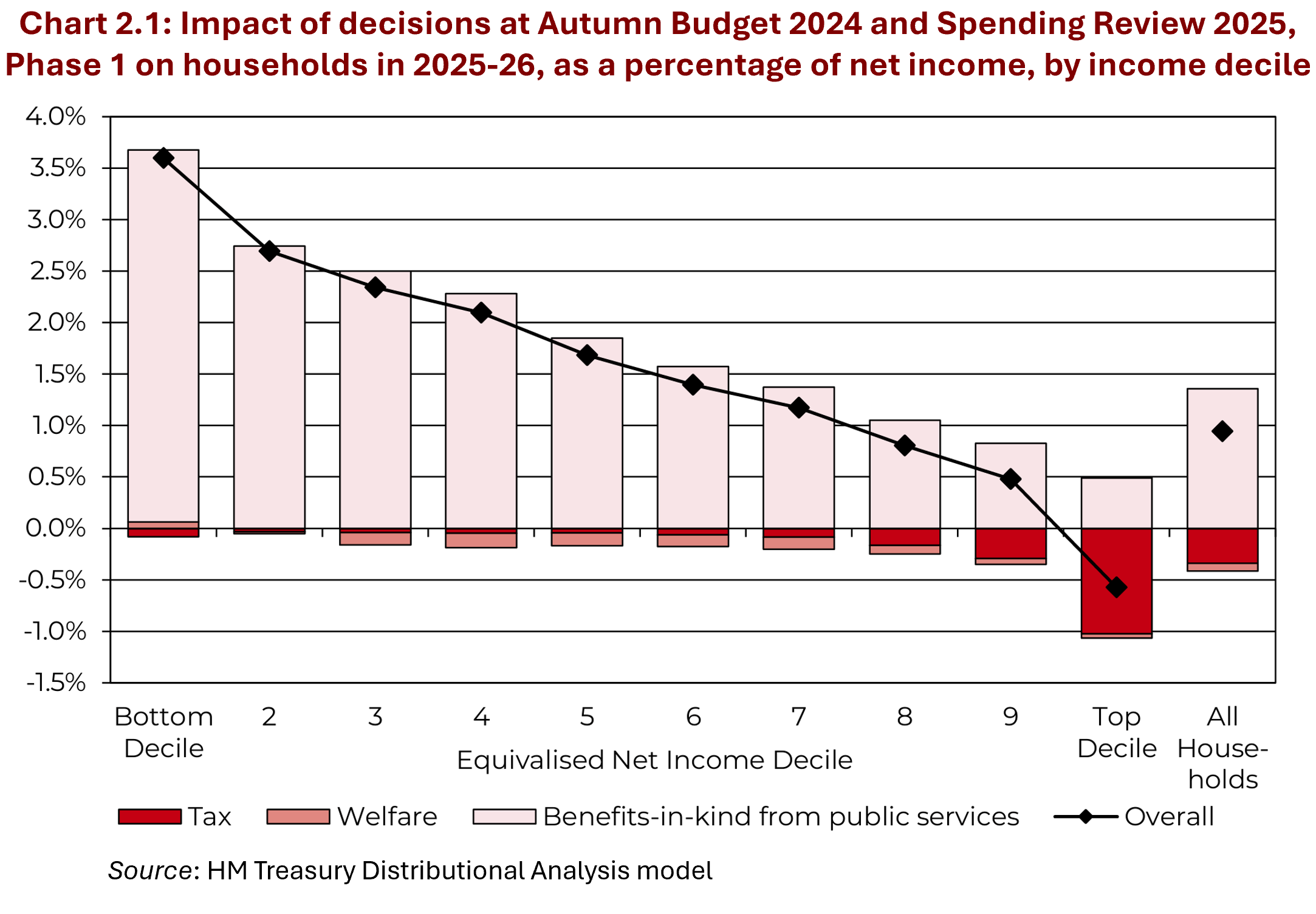 The first Budget of the new UK Labour government was announced on 30 October 2024. It contained a number of measures that will help to tackle inequality. These include extra spending on health and education. This will benefit households on lower incomes the most as a percentage of net income. Increases in tax, by contrast, will be paid predominantly by those on higher incomes. The Chart opposite (taken from the Budget Report) illustrates this. It shows that the poorest 10% will benefit from the largest percentage gain, while the richest 10% will be the only decile that loses.
The first Budget of the new UK Labour government was announced on 30 October 2024. It contained a number of measures that will help to tackle inequality. These include extra spending on health and education. This will benefit households on lower incomes the most as a percentage of net income. Increases in tax, by contrast, will be paid predominantly by those on higher incomes. The Chart opposite (taken from the Budget Report) illustrates this. It shows that the poorest 10% will benefit from the largest percentage gain, while the richest 10% will be the only decile that loses.
But one of the major ways of tackling inequality and poverty was raising the minimum wage. The so-called ‘National Living Wage (NLW)’, paid to those aged 21 and over, will rise in April by 6.7% – from £11.44 to £12.41 per hour. The minimum wage paid to those aged 18 to 20 will rise 16.3% from £8.60 to £10.00 and for 16 and 17 year-olds and apprentices it will rise £18% from £6.40 to £7.55.
 It has been an objective of governments for several years to relate the minimum wage to the median wage. In 2015, the Conservative Government set a target of raising the minimum wage rate to 60 per cent of median hourly earnings by 2020. When that target was hit a new one was set to reach two-thirds of median hourly earnings by 2024.
It has been an objective of governments for several years to relate the minimum wage to the median wage. In 2015, the Conservative Government set a target of raising the minimum wage rate to 60 per cent of median hourly earnings by 2020. When that target was hit a new one was set to reach two-thirds of median hourly earnings by 2024.
The Labour government has set a new remit for the minimum wage (NLW). There are two floors. The first is the previously agreed one, that the NLW should be at least two-thirds of median hourly earnings; the second is that it should fully compensate for cost of living rises and for expected inflation up to March 2026. The new rate of £12.41 will meet both criteria. According to the Low Pay Commission, ‘Wages have risen faster than inflation over the past 12 months, and are forecast to continue to do so up to March 2026’. This makes the first floor the dominant one: meeting the first floor automatically meets the second.
How effective is the minimum wage in reducing poverty and inequality?
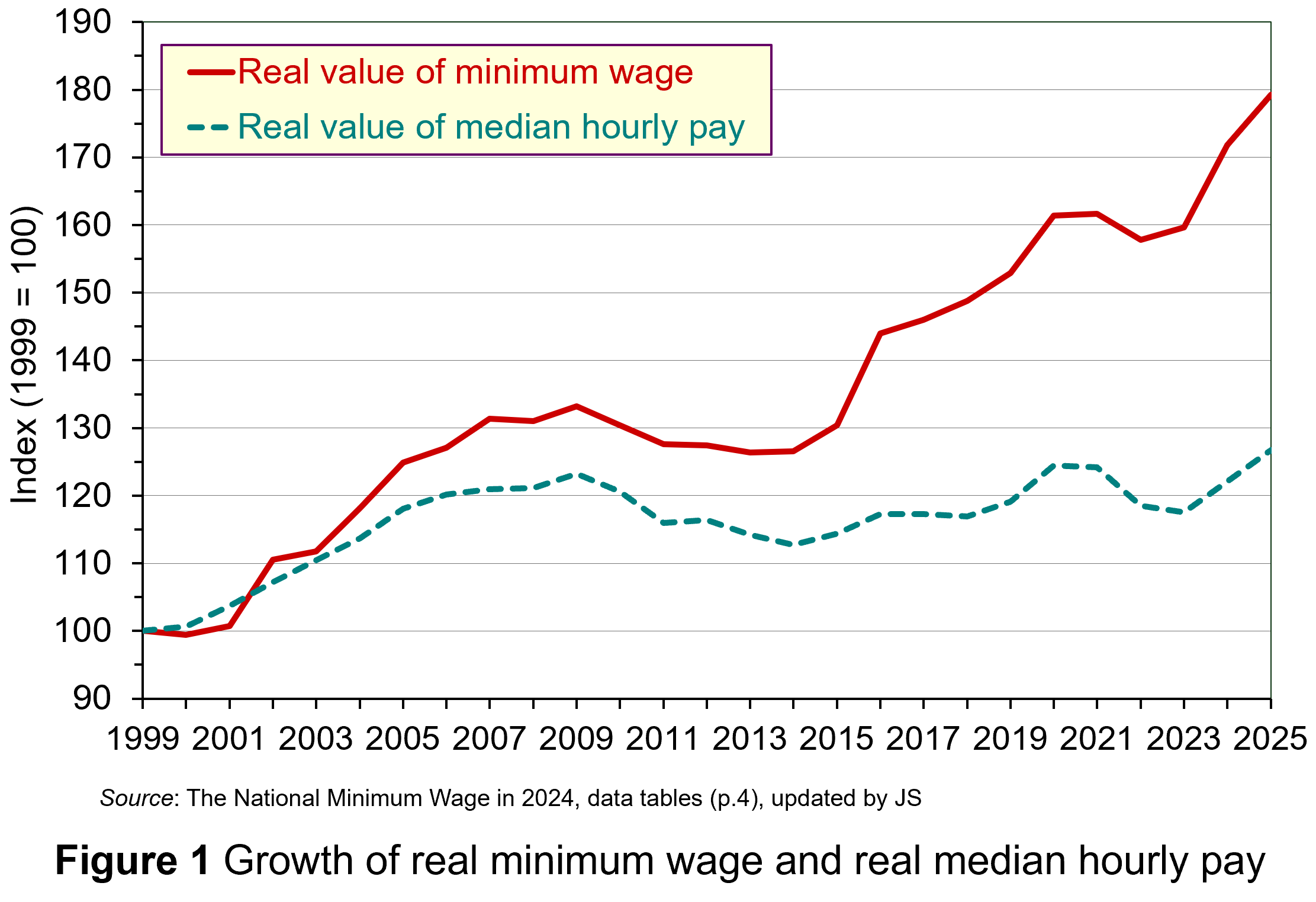 Figure 1 shows the growth in minimum wage rates since their introduction in 1999. The figures are real figures (i.e. after taking into account CPI inflation) and are expressed as an index, with 1999 = 100. The chart also shows the growth in real median hourly pay. (Click here for a Powerpoint.)
Figure 1 shows the growth in minimum wage rates since their introduction in 1999. The figures are real figures (i.e. after taking into account CPI inflation) and are expressed as an index, with 1999 = 100. The chart also shows the growth in real median hourly pay. (Click here for a Powerpoint.)
As you can see, the growth in real minimum wage rates has considerably exceeded the growth in real median hourly pay. This has had a substantial effect on raising the incomes of the poorest workers and thereby has helped to reduce poverty and inequality.
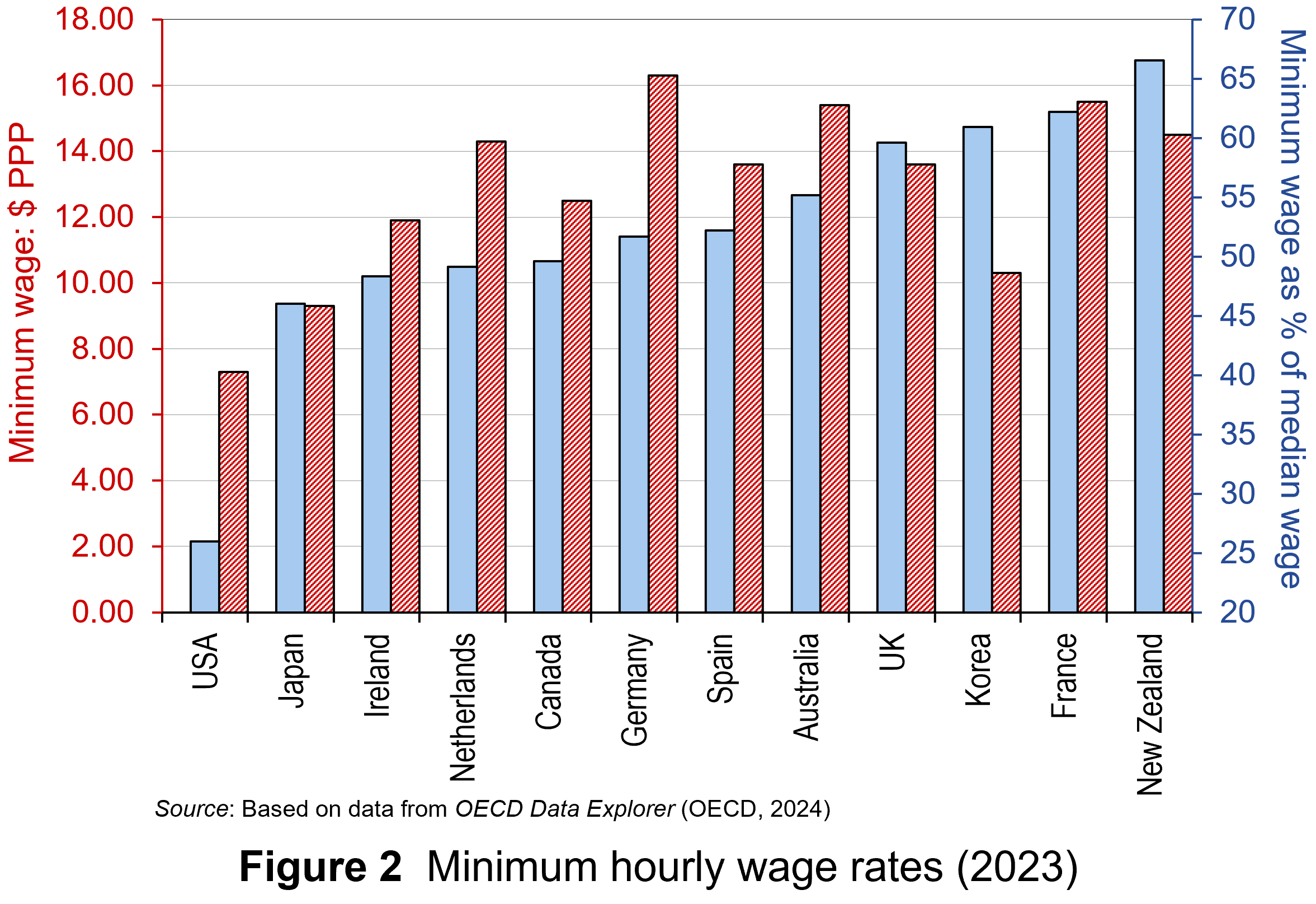 The UK minimum wage compares relatively favourably with other high-income economies. Figure 2 shows minimum wage rates in 12 high-income countries in 2023 – the latest year for which data are available. (Click here for a PowerPoint.) The red bars (striped) show hourly minimum wage rates in US dollars at purchasing-power parity (PPP) rates. PPP rates correct current exchange rates to reflect the purchasing power of each country’s currency. The blue bars (plain) show minimum wage rates as a percentage of the median wage rate. In 2023 the UK had the fourth highest minimum wage of the 12 countries on this measure (59.6%). As we have seen above, the 2025 rate is expected to be 2/3 of the median rate.
The UK minimum wage compares relatively favourably with other high-income economies. Figure 2 shows minimum wage rates in 12 high-income countries in 2023 – the latest year for which data are available. (Click here for a PowerPoint.) The red bars (striped) show hourly minimum wage rates in US dollars at purchasing-power parity (PPP) rates. PPP rates correct current exchange rates to reflect the purchasing power of each country’s currency. The blue bars (plain) show minimum wage rates as a percentage of the median wage rate. In 2023 the UK had the fourth highest minimum wage of the 12 countries on this measure (59.6%). As we have seen above, the 2025 rate is expected to be 2/3 of the median rate.
Minimum wages are just one mechanism for reducing poverty and inequality. Others include the use of the tax and benefit system to redistribute incomes. The direct provision of services, such as health, education and housing at affordable rents can make a significant difference and, as we have seen, have been a major focus of the October 2024 Budget.
The government has been criticised, however, for not removing the two-child limit to extra benefits in Universal Credit (introduced in 2017). The cap clearly disadvantages poor families with more than two children. What is more, for workers on Universal Credit, more than half of the gains from the higher minimum wages will lost because they will result in lower benefit entitlement. Also the freeze in (nominal) personal income tax allowances will mean more poor people will pay tax even with no rise in real incomes.
Effects on employment: analysis
A worry about raising the minimum wage rate is that it could reduce employment in firms already paying the minimum wage and thus facing a wage rise.
In the case of a firm operating in competitive labour and goods markets, the demand for low-skilled workers is relatively wage sensitive. Any rise in wage rates, and hence prices, by this firm alone would lead to a large fall in sales and hence in employment.
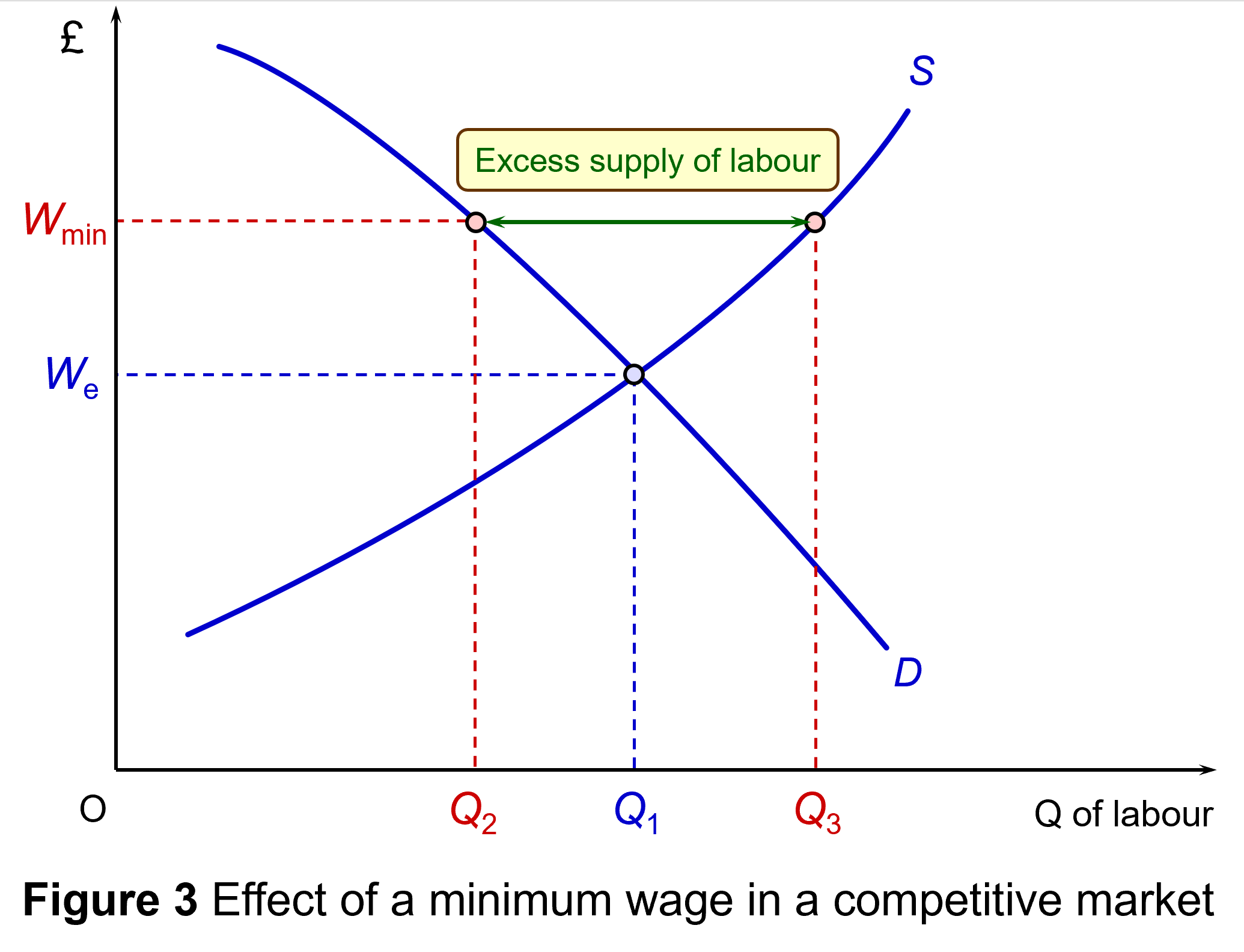 This is illustrated in Figure 3 (click here for a PowerPoint). Assume that the minimum wage is initially the equilibrium wage rate We. Now assume that the minimum wage is raised to Wmin. This will cause a surplus of labour (i.e. unemployment) of Q3 – Q2. Labour supply rises from Q1 to Q3 and the demand for labour falls from Q1 to Q2.
This is illustrated in Figure 3 (click here for a PowerPoint). Assume that the minimum wage is initially the equilibrium wage rate We. Now assume that the minimum wage is raised to Wmin. This will cause a surplus of labour (i.e. unemployment) of Q3 – Q2. Labour supply rises from Q1 to Q3 and the demand for labour falls from Q1 to Q2.
But, given that all firms face the minimum wage, individual employers are more able to pass on higher wages in higher prices, knowing that their competitors are doing the same. The quantity of labour demanded in any given market will not fall so much – the demand is less wage elastic; and the quantity of labour supplied in any given market will rise less – the supply is less wage elastic. Any unemployment will be less than that illustrated in Figure 3. If, at the same time, the economy expands so that the demand-for-labour curve shifts to the right, there may be no unemployment at all.
When employers have a degree of monopsony power, it is not even certain that they would want to reduce employment. This is illustrated in Figure 4: click here for a PowerPoint (you can skip this section if you are not familiar with the analysis).
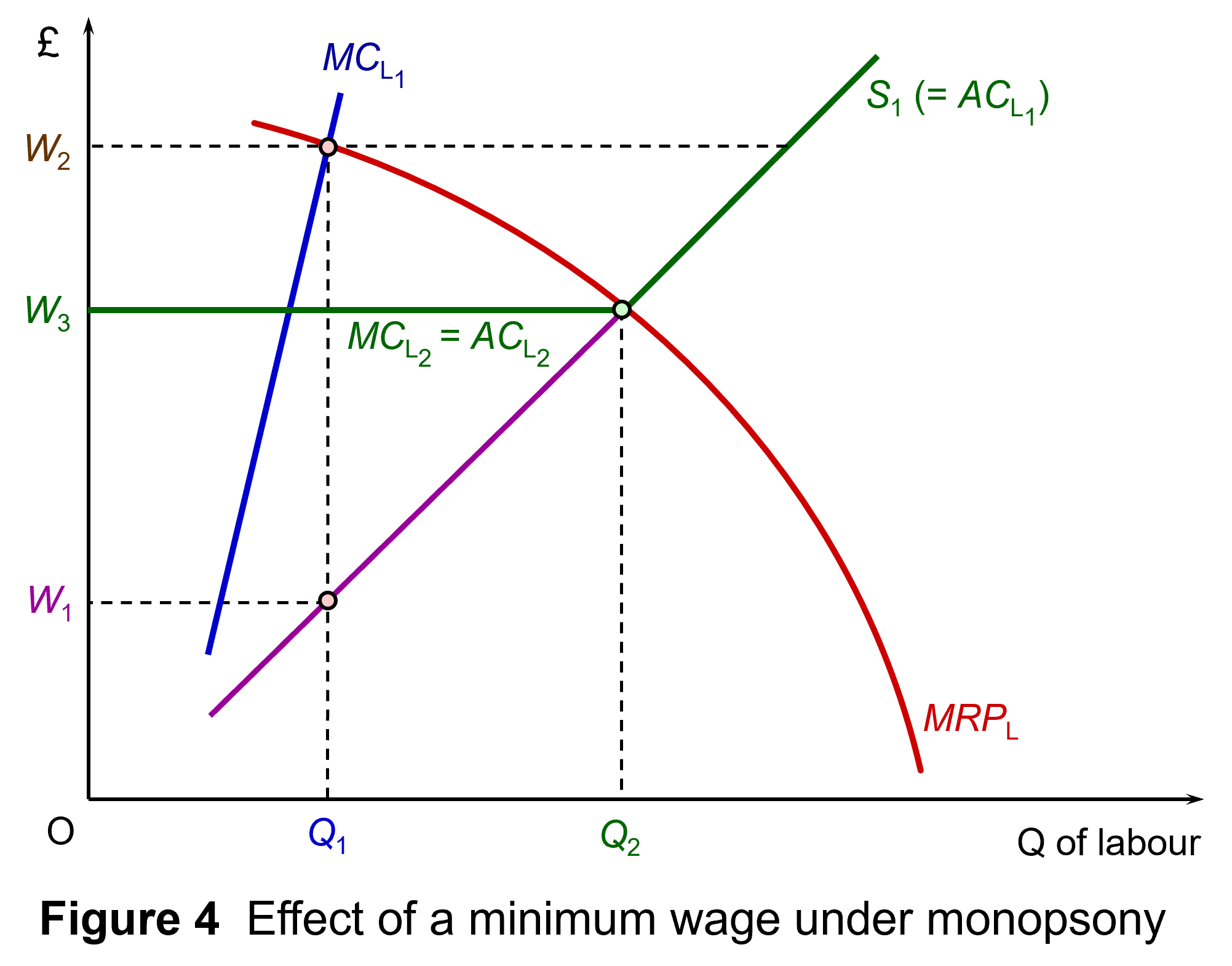 Assume initially that there is no minimum wage. The supply of labour to the monopsony employer is given by curve SL1, which is also the average cost of labour ACL1. A higher employment by the firm will drive up the wage; a lower employment will drive it down. This gives a marginal cost of labour curve of MCL1. Profit-maximising employment will be Q1, where the marginal cost of labour equals the marginal revenue product of labour (MRPL). The wage, given by the SL1 (=ACL1) line will be W1.
Assume initially that there is no minimum wage. The supply of labour to the monopsony employer is given by curve SL1, which is also the average cost of labour ACL1. A higher employment by the firm will drive up the wage; a lower employment will drive it down. This gives a marginal cost of labour curve of MCL1. Profit-maximising employment will be Q1, where the marginal cost of labour equals the marginal revenue product of labour (MRPL). The wage, given by the SL1 (=ACL1) line will be W1.
Now assume that there is a minimum wage. Assume also that the initial minimum wage is at or below W1. The profit-maximising employment is thus Q1 at a wage rate of W1.
The minimum wage can be be raised as high as W2 and the firm will still want to employ as many workers as at W1. The point is that the firm can no longer drive down the wage rate by employing fewer workers, and so the ACL1 curve becomes horizontal at the new minimum wage and hence will be the same as the MCL curve (MCL2 = ACL2). Profit-maximising employment will be where the MRPL curve equals this horizontal MCL curve. The incentive to cut its workforce, therefore, has been removed.
Again, if we extend the analysis to the whole economy, a rise in the minimum wage will be partly passed on in higher prices or stimulate employers to increase labour productivity. The effect will be to shift the (MRPL) curve upwards to the right, thereby allowing the firm to pass on higher wages and reducing any incentive to reduce employment.
Effects on employment: evidence
There is little evidence that raising the minimum wage in stages will create unemployment, although it may cause some redeployment. In the Low Pay Commission’s 2019 report, 20 years of the National Minimum Wage (see link below), it stated that since 2000 it had commissioned more than 30 research projects looking at the NMW’s effects on hours and employment and had found no strong evidence of negative effects. Employers had adjusted to minimum wages in various ways. These included reducing profits, increasing prices and restructuring their business and workforce.
Along with our commissioned work, other economists have examined the employment effects of the NMW in the UK and have for the most part found no impact. This is consistent with international evidence suggesting that carefully set minimum wages do not have noticeable employment effects. While some jobs may be lost following a minimum wage increase, increasing employment elsewhere offsets this. (p.20)
There is general agreement, however, that a very large increase in minimum wages will impact on employment. This, however, should not be relevant to the rise in the NLW from £11.44 to £12.41 per hour in April 2025, which represents a real rise of around 4.5%. This at worst should have only a modest effect on employment and could be offset by economic growth.
 What, however, has concerned commentators more is the rise in employers’ National Insurance contributions (NICs) that were announced in the Budget. In April 2025, the rate will increase from 13.8% to 15%. Employers’ NICs are paid for each employee on all wages above a certain annual threshold. This threshold will fall in April from £9100 to £5000. So the cost to an employer of an employee earning £38 000 per annum in 2024/25 would be £38 000 + ((£38 000 – £9100) × 0.138) = £41 988.20. For the year 2025/26 it will rise to £38 000 + ((£38 000 – £5000) × 0.15) = £42 950. This is a rise of 2.29%. (Note that £38 000 will be approximately the median wage in 2025/26.)
What, however, has concerned commentators more is the rise in employers’ National Insurance contributions (NICs) that were announced in the Budget. In April 2025, the rate will increase from 13.8% to 15%. Employers’ NICs are paid for each employee on all wages above a certain annual threshold. This threshold will fall in April from £9100 to £5000. So the cost to an employer of an employee earning £38 000 per annum in 2024/25 would be £38 000 + ((£38 000 – £9100) × 0.138) = £41 988.20. For the year 2025/26 it will rise to £38 000 + ((£38 000 – £5000) × 0.15) = £42 950. This is a rise of 2.29%. (Note that £38 000 will be approximately the median wage in 2025/26.)
However, for employees on the new minimum wage, the percentage rise in employer NICs will be somewhat higher. A person on the new NLW of £12.41, working 40 hours per week and 52 weeks per year (assuming paid holidays), will earn an annual wage of £25 812.80. Under the old employer NIC rates, the employer would have paid (£25 812.80 + (£25 812.80 – £9100) × 0.138) = £28 119.17. For the year 2025/26, it will rise to £25 812.80 + ((£25 812.80 – £5000) × 0.15) = £28 934.72. This is a rise of 2.90%.
This larger percentage rise in employers’ wage costs for people on minimum wages than those on median wages, when combined with the rise in the NLW, could have an impact on the employment of those on minimum wages. Whether it does or not will depend on how rapid growth is and how much employers can absorb the extra costs through greater productivity and/or passing on the costs to their customers.
Articles
- National Living Wage to increase to £12.21 in April 2025
Low Pay Commission, Press Release (29/10/24)
- Rachel Reeves hands low-paid a £1,400 boost as minimum wage to rise by 6.7%
Independent, Archie Mitchell and Millie Cooke (31/10/24)
- Minimum wage to rise to £12.21 an hour next year
BBC News, Michael Race (29/10/24)
- What Labour’s first budget means for wages, taxes, business, the NHS and plans to grow the economy – experts explain
The Conversation, Rachel Scarfe et al. (30/10/24)
- The two-child limit: poverty, incentives and cost
Institute for Fiscal Studies, Eduin Latimer and Tom Waters (17/6/24)
UK Government reports and information
Data
Questions
- How is the October 2024 Budget likely to affect the distribution of income?
- What are the benefits and limitations of statutory minimum wages in reducing (a) poverty and (b) inequality?
- Under what circumstances will a rise in the minimum wage lead or not lead to an increase in unemployment?
- Find out what is meant by the UK Real Living Wage (RLW) and distinguish it from the UK National Living Wage (NLW). Why is the RLW higher?
- Why is the median wage rather than the mean wage used in setting the NLW?
 This is the first of three blogs looking at inflation, at its effect on household budgets and at monetary policy to bring inflation back to the target rate. This first one takes an overview.
This is the first of three blogs looking at inflation, at its effect on household budgets and at monetary policy to bring inflation back to the target rate. This first one takes an overview.
The housing and mortgage markets are vitally important to the financial well-being of many households. We have seen this vividly in recent times through the impact of rising inflation rates on interest rates and, in turn, on mortgage repayments. Some people on variable rate mortgages, or whose fixed rate deals are coming to the end of their term, have struggled to pay the new higher rates. In this blog we explore the reasons behind these events and the extent to which the financial well-being of UK households has been affected.
Chart 1 shows the path of inflation in the UK since 1997 when the Bank of England’s Monetary Policy Committee (MPC) was first charged with meeting an inflation rate target (click here for a PowerPoint). It captures the impact of the inflation shock that began to emerge in 2021 and saw the CPI inflation rate peak at 11.1 per cent in October 2022 – considerably above the Bank’s 2 per cent target.
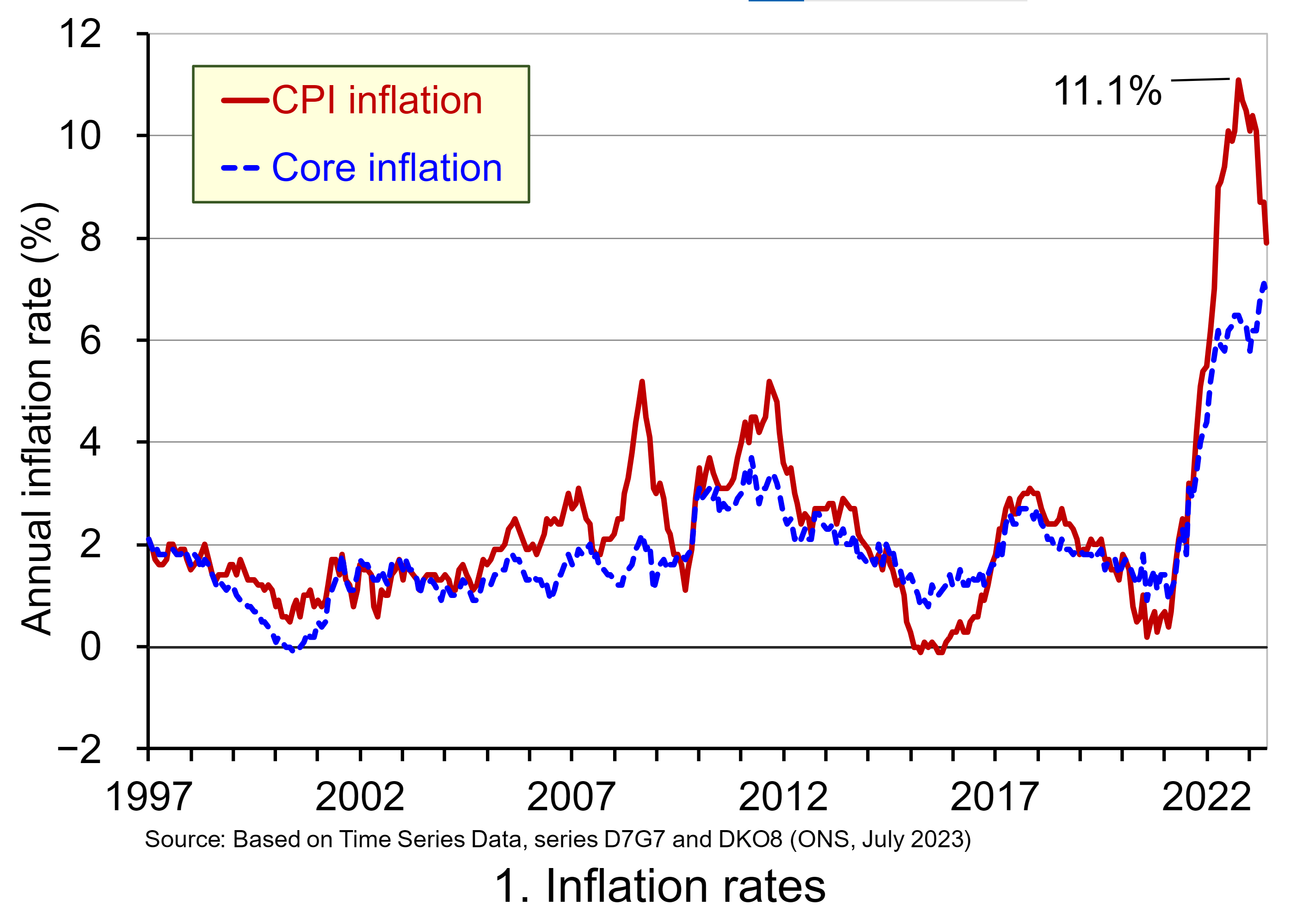 Despite easing somewhat, the CPI inflation rate is showing signs of persistence – meaning that it is taking time for it to return to target. One way of understanding this persistence is to look at a measure of inflation known as core inflation. This inflation rate measure excludes energy, food, alcoholic beverages and tobacco prices, all of which are notoriously volatile. Core inflation thus captures underlying inflationary pressures.
Despite easing somewhat, the CPI inflation rate is showing signs of persistence – meaning that it is taking time for it to return to target. One way of understanding this persistence is to look at a measure of inflation known as core inflation. This inflation rate measure excludes energy, food, alcoholic beverages and tobacco prices, all of which are notoriously volatile. Core inflation thus captures underlying inflationary pressures.
To address the inflationary pressures, the Bank of England began raising Bank Rate in December 2021 from a low of just 0.1 per cent. By June 2023 the Bank Rate had risen to 5 per cent with the prospect of further hikes. As the Bank Rate rises, the cost of borrowing from the Bank of England by commercial banks rises too. Therefore increases in the Bank Rate ripple through to other interest rates. However, the passthrough effect can be uneven affecting spreads between Bank Rate and other interest rates.
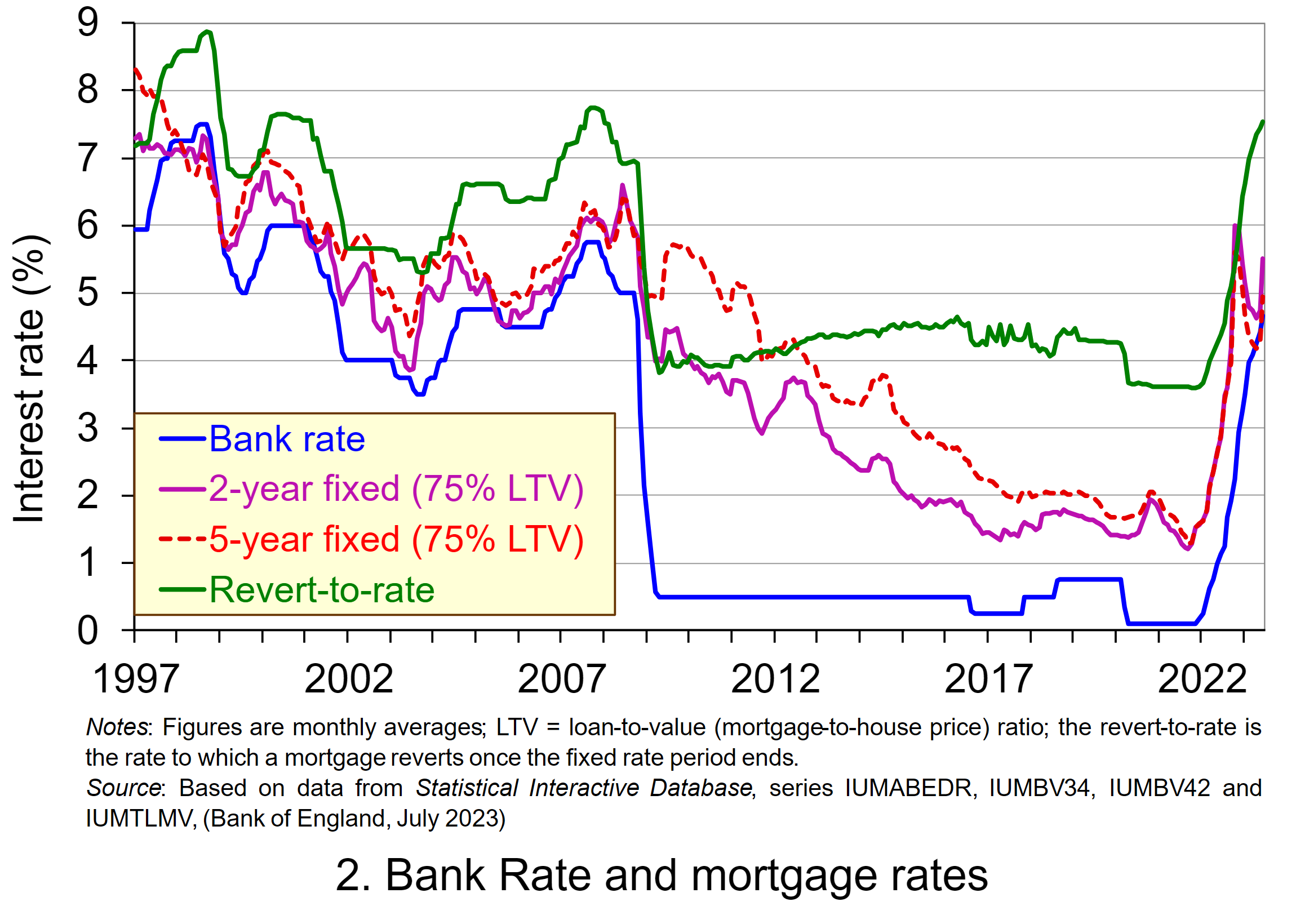 The increase in the Bank Rate is reflected in the increases in mortgage rates shown in Chart 2 (click here for a PowerPoint). As we have seen, this affects most immediately those with variable rate mortgages, and then those with fixed-rate mortgages as they come up for renewal. Analysis from the Resolution Foundation (2023) estimates that 4.2 million households saw their mortgage rates change between December 2021 and June 2023 – the equivalent of 56 per cent of mortgaged households.
The increase in the Bank Rate is reflected in the increases in mortgage rates shown in Chart 2 (click here for a PowerPoint). As we have seen, this affects most immediately those with variable rate mortgages, and then those with fixed-rate mortgages as they come up for renewal. Analysis from the Resolution Foundation (2023) estimates that 4.2 million households saw their mortgage rates change between December 2021 and June 2023 – the equivalent of 56 per cent of mortgaged households.
The persistence of inflation means that mortgage rates may not have yet peaked and are likely to stay higher for longer than originally thought. With fixes normally between two to five years, the problem of higher rates for those renewing will continue. The Resolution Foundation projects that by the end of 2026, almost all households with a mortgage would have moved to a higher rate since December 2021. At this point, the typical annual repayment cost for mortgaged households is forecast to be £2000 per annum higher, leading to an increase in annual repayments for the UK household sector of £15.8 billion.
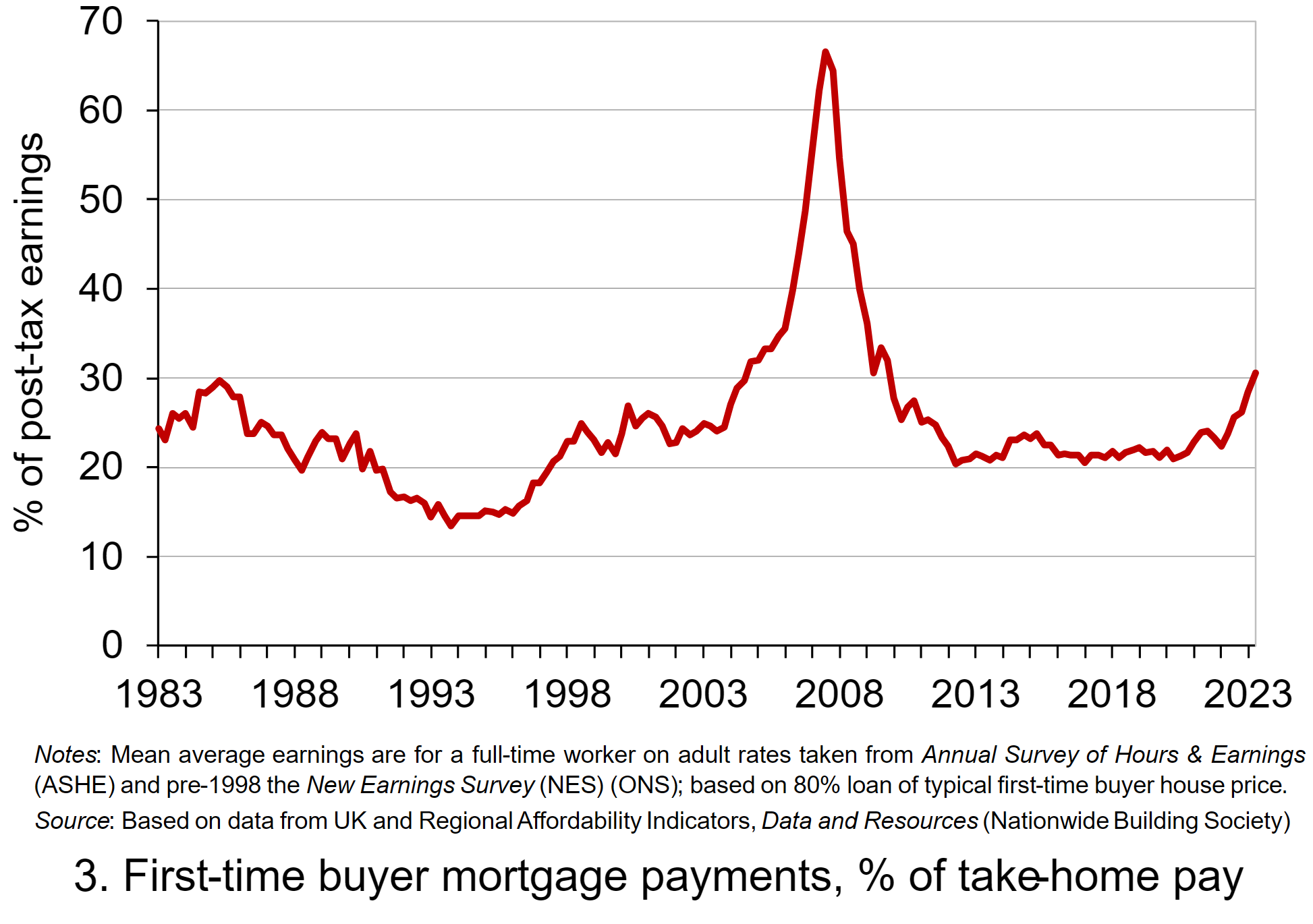 Chart 3 provides a visual picture of the typical annual repayment costs facing first-time buyers as a percentage of earnings after tax and national insurance (click here for a PowerPoint). The Nationwide Building Society figures are based on an 80% loan on the typical first-time buyer house price. It shows that repayment costs have been rising sharply on the back of rising interest rates and are now higher than at any time since the global financial crisis of 2007–8.
Chart 3 provides a visual picture of the typical annual repayment costs facing first-time buyers as a percentage of earnings after tax and national insurance (click here for a PowerPoint). The Nationwide Building Society figures are based on an 80% loan on the typical first-time buyer house price. It shows that repayment costs have been rising sharply on the back of rising interest rates and are now higher than at any time since the global financial crisis of 2007–8.
Articles
- UK inflation to fall to lowest level since March 2022 but Bank of England still tipped to hike interest rates
City A.M., Jack Barnett (17/7/23)
- UK inflation and interest rates high – how do other economies compare?
BBC News, Dharshini David (23/7/23)
- Mortgage payments set to jump by £500 for one million households
BBC News, Tom Espiner (13/7/23)
- Interest rates: Big rise less likely after inflation surprise
BBC News, Daniel Thomas, Faisal Islam & Dharshini David (19/7/23)
- Rising Mortgage Costs. What Can Be Done?
NIESR blog, Max Mosley and Adrian Pabst (17/7/23)
- UK interest rates forecast to rise less sharply after inflation falls to 7.9%
The Guardian, Richard Partington (19/7/23)
- Mortgage costs: More Scots falling behind on repayments
Herald Scotland, Kristy Dorsey (18/7/23)
- The Mortgage Crunch
Resolution Foundation, Simon Pittaway (17/6/23)
- Peaked Interest?
Resolution Foundation, Molly Broome, Ian Mulheirn and Simon Pittaway (17/7/23)
Data
Questions
- What possible indicators could be used to assess the affordability of residential house prices?
- What is captured by the rate of core inflation? Discuss the arguments for using this as the target inflation rate measure.
- What factors might affect the proportion of people taking out fixed-rate mortgages rather than variable-rate mortgages?
- Discuss the ways by which house price changes could impact on household consumption.
- Investigate the proportion of mortgages that are fixed rate and the typical length of the fixed rate term in two European countries, the USA and Japan. How does each differ from the UK?
On 3 November, the Bank of England announced the highest interest rate rise in 33 years. It warned that the UK is facing the longest recession since records began. With the downturn starting earlier than expected and predicted to last for longer, households, businesses and the government are braced for a challenging few years ahead.
Interest rates
 The Monetary Policy Committee increased Bank Rate to 3% from the previous rate of 2.25%. This 75-basis point increase is the largest since 1989 and is the eighth rise since December. What is more, the Bank has warned that it will not stop there. These increases in interest rates are there to try to tackle inflation, which rose to 10.1% in September and is expected to be 11% for the final quarter of this year. Soaring prices are a growing concern for UK households, with the cost of living rising at the fastest rate for 40 years. It is feared that such increases in the Bank’s base rate will only worsen household circumstances.
The Monetary Policy Committee increased Bank Rate to 3% from the previous rate of 2.25%. This 75-basis point increase is the largest since 1989 and is the eighth rise since December. What is more, the Bank has warned that it will not stop there. These increases in interest rates are there to try to tackle inflation, which rose to 10.1% in September and is expected to be 11% for the final quarter of this year. Soaring prices are a growing concern for UK households, with the cost of living rising at the fastest rate for 40 years. It is feared that such increases in the Bank’s base rate will only worsen household circumstances.
There are various causes of the current cost-of-living crisis. These include the pandemic’s effect on production, the aftermath in terms of supply-chain problems and labour shortages, the war in Ukraine and its effect on energy and food prices, and poor harvests in many parts of the world, including many European countries. It has been reported that grocery prices in October were 4.7% higher than in October 2021. This is the highest rate of food price inflation on record and means shoppers could face paying an extra £682 per year on average.
There is real concern about the impact of the interest rates rise on the overall economy but, in particular, on peoples’ mortgages. Bank of England Governor, Andrew Bailey, warned of a ‘tough road ahead’ for UK households, but said that the MPC had to act forcefully now or things ‘will be worse later on’.
However, it could be argued that there was a silver lining in Thursday’s announcement. The future rises in interest rates are predicted to peak at a lower rate than previously thought. Amongst all the mini-budget chaos, there was concern that rates could surpass the 6% mark. Now the Bank of England has given the assurance that future rate rises will be limited and that Bank Rate should not increase beyond 5% by next autumn. The Bank was keen to reassure markets of this by making clear the thinking behind the decision in the published minutes of MPC meeting.
Recession
 With the Bank warning of the longest recession since records began, what does this actually mean? Economies experience periods of growth and periods of slowdown or even decline in real GDP. However, a recession is defined as when a country’s economy shrinks for two three-month periods (quarters) in a row. The last time the UK experienced a recession was in 2020 during the height of the pandemic. During a recession, businesses typically make less profits, pay falls, some people may lose their jobs and unemployment rises. This means that the government receives less money in taxation to use on public services such as health and education. Graduates and school leavers could find it harder to get their first job, while others may find it harder to be promoted or to get big enough pay rises to keep pace with price increases. However, the pain of a recession is typically not felt equally across society, and inequality can increase.
With the Bank warning of the longest recession since records began, what does this actually mean? Economies experience periods of growth and periods of slowdown or even decline in real GDP. However, a recession is defined as when a country’s economy shrinks for two three-month periods (quarters) in a row. The last time the UK experienced a recession was in 2020 during the height of the pandemic. During a recession, businesses typically make less profits, pay falls, some people may lose their jobs and unemployment rises. This means that the government receives less money in taxation to use on public services such as health and education. Graduates and school leavers could find it harder to get their first job, while others may find it harder to be promoted or to get big enough pay rises to keep pace with price increases. However, the pain of a recession is typically not felt equally across society, and inequality can increase.
The Bank had previously expected the UK to fall into recession at the end of this year but the latest data from the Office for National Statistics (ONS) show that GDP fell by 0.3% in the three months to August. The Bank is predicting that GDP will shrink by 0.5% between May and August 2023, followed by a further fall of 0.3% between September and December. The Bank then expects the UK economy to remain in recession throughout 2023 and the first half of 2024.
With the higher interest rates, borrowing costs are now at their highest since 2008, when the UK banking system faced collapse in the wake of the global financial crisis. The Bank believes that by raising interest rates it will make it more expensive to borrow and encourage people not to spend money, easing the pressure on prices in the process. It does, however, mean that savers will start to benefit from higher rates (but still negative real rates), but it will have a knock-on effect on those with mortgages, credit card debt and bank loans.
The recession in 2020 only lasted for six months, although the 20.4% reduction in the UK economy between April and June that year was the largest on record. The one before that started in 2008 with the global financial crisis and went on for five quarters. Whilst it will not be the UK’s deepest downturn, the Bank stressed that it will be the longest since records began in the 1920s.
Mortgages
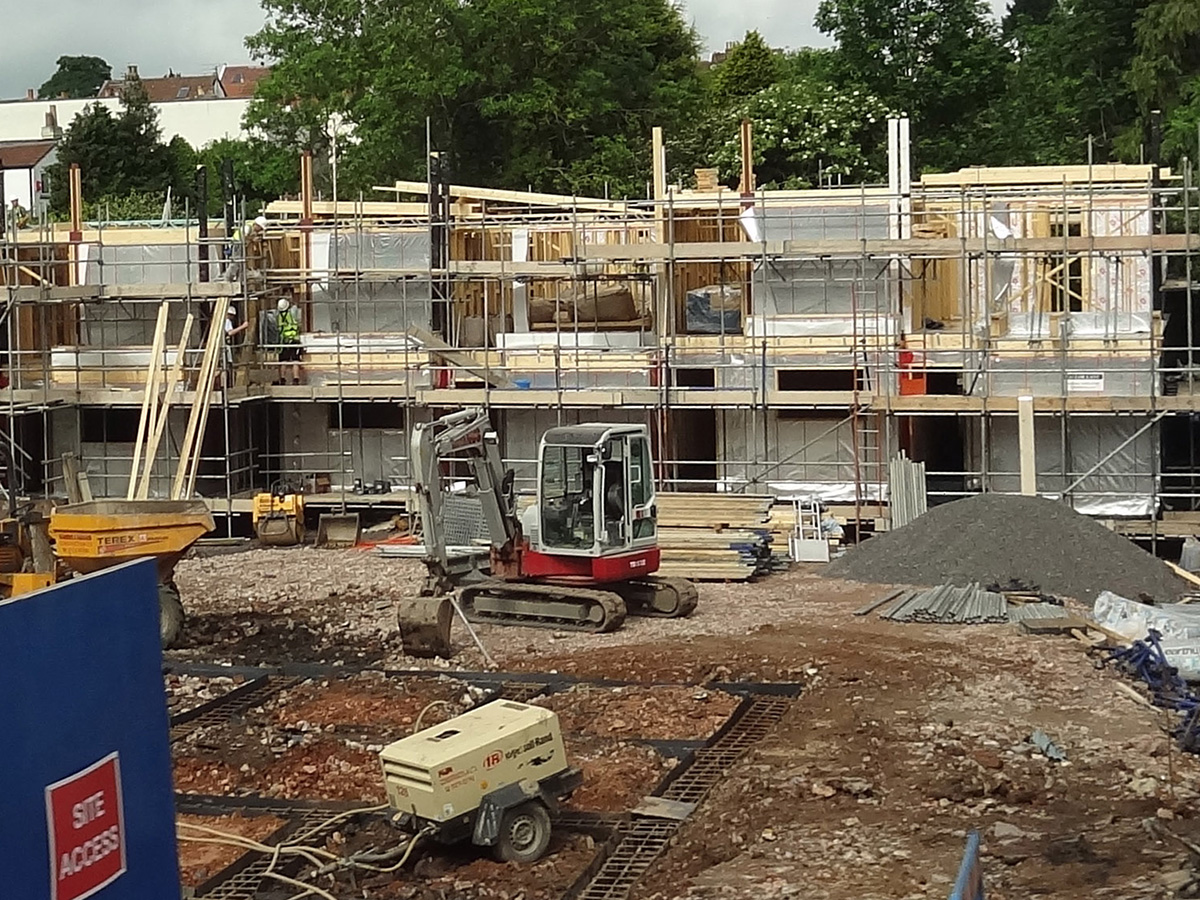 Those with mortgages are rightly feeling nervous about the impact that further increases in mortgage interest rates will have on their budgets. Variable mortgage rates and new fixed rates have been rising for several months because of this year’s run of rate rises but they shot up after the mini-Budget. The Bank forecasts that if interest rates continue to rise, those whose fixed rate deals are coming to an end could see their annual payments soar by an average of £3000.
Those with mortgages are rightly feeling nervous about the impact that further increases in mortgage interest rates will have on their budgets. Variable mortgage rates and new fixed rates have been rising for several months because of this year’s run of rate rises but they shot up after the mini-Budget. The Bank forecasts that if interest rates continue to rise, those whose fixed rate deals are coming to an end could see their annual payments soar by an average of £3000.
Homebuyers with tracker or variable rate mortgages will feel the pain of the rate rise immediately, while the estimated 300 000 people who must re-mortgage this month will find that two-year and five-year fixed rates remain at levels not seen since the 2008 financial crisis. However, the Bank said that the cost of fixed-rate mortgages had already come down from the levels seen at the height of the panic in the wake of Kwasi Kwarteng’s mini-Budget, which sent them soaring above 6%.
There is a fear of the devastating impact on those who simply cannot afford further increases in payments. The Joseph Rowntree Foundation (JRF) said an extra 120 000 households in the UK, the equivalent of 400 000 people, will be plunged into poverty when their current mortgage deal ends. The analysis assumes that mortgage rates remain high, with homeowners forced to move to an interest rate of around 5.5%. For people currently on fixed rates typically of around of 2% which are due to expire, this change would mean a huge increase. Such people, on average, would find the proportion of their monthly income going on housing costs rising from 38% to 54%. In cash terms this equates to an average increase of £250, from £610 a month to £860 a month.
In addition to these higher monthly home-loan costs threatening to pull another 400 000 people into poverty, such turmoil in the mortgage market would increase competition for rental properties and could result in rents for new lets rising sharply as the extra demand allows buy-to-let landlords to pass on their higher loan costs (or more).
Unemployment
Since the mini-Budget, the level of the pound and government borrowing costs have somewhat recovered. However, mortgage markets and business loans are still showing signs of stress, adding to the prolonged hit to the economy. The Bank now forecasts that the unemployment rate will rise, while household incomes will come down too. The unemployment rate is currently at its lowest for 50 years, but it is expected to rise to nearly 6.5%.
Looking to the future
 It is the case that the lasting effects of the pandemic, the war in Ukraine and the energy shock have all played their part in the current economic climate. However, it could be argued that the Bank and the government are now making decisions that will inflict further pain and sacrifice for millions of households, who are already facing multi-thousand-pound increases in mortgage, energy and food bills.
It is the case that the lasting effects of the pandemic, the war in Ukraine and the energy shock have all played their part in the current economic climate. However, it could be argued that the Bank and the government are now making decisions that will inflict further pain and sacrifice for millions of households, who are already facing multi-thousand-pound increases in mortgage, energy and food bills.
There have been further concerns raised about the possible tax rises planned by the Chancellor Jeremy Hunt. If large tax rises and spending cuts are set out in the Autumn Statement of 17 November, the Bank of England’s chief economist has warned that Britain risks a deeper than expected economic slowdown. This could weigh on the British economy by more than the central bank currently anticipates, in a development that would force it to rethink its approach to setting interest rates.
There is no doubt that the future economic picture looks painful, with the UK performing worse than the USA and the eurozone. The Bank Governor, Andrew Bailey, believes that the mini-Budget had damaged the UK’s reputation internationally, stating, ‘it was very apparent to me that the UK’s position and the UK’s standing had been damaged’. However, both the Governor and the Chancellor or the Exchequer agree that action needs to be taken now in order for the economy to stabilise long term.
Jeremey Hunt, the Chancellor, explained that the most important thing the British government can do right now is to restore stability, sort out the public finances and get debt falling so that interest rate rises are kept as low as possible. This echoes the Bank’s belief in the importance of acting forcefully now in order to prevent things being much worse later on. With the recession predicted to last into 2024, the same year as a possible general election, the Conservatives face campaigning to remain in government at the tail end of a prolonged slump.
Report
Articles
- Bank of England expects UK to fall into longest ever recession
BBC News, Dearbail Jordan & Daniel Thomas (4/11/22)
- What is a recession and how could it affect me?
BBC News (3/11/22)
- Is it right to raise interest rates in a recession?
BBC News, Faisal Islam (4/11/22)
- Rising interest rates: why the Bank of England has increased rates again and what to expect next
The Conversation, Francesc Rodriguez-Tous (7/11/22)
- Bank of England raises interest rates by 0.75 percentage points
Financial Times, Chris Giles and Delphine Strauss (3/11/22)
- Bank of England raises its benchmark rate by 75 basis points, its biggest hike in 33 years
CNBC, Elliot Smith (3/11/22)
- Interest rate rises to 3% as Bank of England imposes biggest hike for three decades
Sky News, Ed Conway (3/11/22)
 Interest Rates: What’s behind the rise?
Interest Rates: What’s behind the rise?Sky News on YouTube, Paul Kelso (3/11/22)
- Falls in UK mortgage rates predicted as BoE signals dovish outlook
Financial Times, James Pickford and Siddharth Venkataramakrishnan (3/11/22)
- BoE outlines two bleak scenarios for taming inflation
Financial Times, Chris Giles (3/11/22)
- Bank of England warns of longest recession in 100 years as it raises rates to 3%
The Guardian, Larry Elliott and Phillip Inman (3/11/22)
- UK mortgage rate rises ‘will put extra 400,000 people in poverty’
The Guardian, Zoe Wood (4/11/22)
- Large tax rises from Jeremy Hunt ‘could put UK at risk of deeper slowdown’
The Guardian, Richard Partington (7/11/22)
- Bank of England will raise interest rates again, says chief economist
The Guardian, Richard Partington (8/11/22)
Questions
- Define the term ‘recession’ and how is it measured.
- Explain what happens to the key macroeconomic indicators during this period of the business cycle.
- Which policies would governments normally implement to get a economy into the
- expansionary/recovery phase of the business cycle and how do they work?
- What is the issue of raising interest rates during a downturn or recession?
- With unemployment expected to rise, explain what type of unemployment this is. What policies could be introduced to reduce this type of unemployment?
 Households are expected to see further rises in the cost of living after the annual inflation rate climbed for a 13th month to its highest point in almost 30 years. This will put further pressure on already stretched household budgets. The increase reflects a bounceback in demand for goods and services after lockdowns, when prices fell sharply. It also reflects the impact of supply-chain disruptions as Covid-19 hit factory production and global trade.
Households are expected to see further rises in the cost of living after the annual inflation rate climbed for a 13th month to its highest point in almost 30 years. This will put further pressure on already stretched household budgets. The increase reflects a bounceback in demand for goods and services after lockdowns, when prices fell sharply. It also reflects the impact of supply-chain disruptions as Covid-19 hit factory production and global trade.
The biggest concern, however, is the impact it will have on those already hard-pressed families across the UK. According to official figures, prices are rising at similar rates for richer and poorer households. However, household income levels will determine personal experiences of inflation. Poorer households find it harder to cope than richer families as essentials, such as energy and food, form a larger proportion of their shopping basket than discretionary items. On average the lowest-income families spend twice as much proportionately on food and housing bills as the richest. So low-income households, if they are already spending mainly on essentials, will struggle to find where to cut back as prices rise.
Latest Inflation figures
Latest figures from the ONS show that the Consumer Prices Index (CPI) rose by 5.5% in the year to January 2022, with further increases in the rate expected over the next couple of months. In measuring inflation, the ONS takes a so-called ‘basket of goods, which is frequently updated to reflect changes in spending patterns. For example, in 2021, hand sanitiser and men’s loungewear bottoms were added, but sandwiches bought at work were removed.
Annual CPI inflation is announced each month, showing how much the weighted average of these prices has risen since the same date last year. The weighted average is expressed as an index, with the index set at 100 in the base year, which is currently 2015.
 Consumers would not normally notice price rises from month to month. However, prices are now rising so quickly that it is clear for everyone to see. What is more, average pay is not keeping up. There are workers in a few sectors, such as lorry drivers, who are in high demand, and therefore their wages are rising faster than prices. But the majority of workers won’t see such increases in pay. In the 12 months to January, prices rose by 5.5% on average, but regular pay, excluding bonuses, on average rose by only 4.7%, meaning that they fell by 0.8% in real terms.
Consumers would not normally notice price rises from month to month. However, prices are now rising so quickly that it is clear for everyone to see. What is more, average pay is not keeping up. There are workers in a few sectors, such as lorry drivers, who are in high demand, and therefore their wages are rising faster than prices. But the majority of workers won’t see such increases in pay. In the 12 months to January, prices rose by 5.5% on average, but regular pay, excluding bonuses, on average rose by only 4.7%, meaning that they fell by 0.8% in real terms.
The Bank of England has warned that CPI inflation could rise to 7% this year and some economists are forecasting that it could be almost 8% in April.
Why are costs rising?
From the weekly food shop, to filling up cars, to heating our homes, the cost of living is rising sharply around the world. Global inflation is at its highest since 2008. Some of the reasons why include:
- Rising energy and petrol prices
 Oil prices slumped at the start of the pandemic, but demand has rocketed back since, and oil prices have hit a seven-year high. The price of gas has also shot up, leaving people around the world with eye-watering central heating bills. Home energy bills in the UK are set to rise by 54% in April when Ofgem, the energy regulator, raises the price cap.
Oil prices slumped at the start of the pandemic, but demand has rocketed back since, and oil prices have hit a seven-year high. The price of gas has also shot up, leaving people around the world with eye-watering central heating bills. Home energy bills in the UK are set to rise by 54% in April when Ofgem, the energy regulator, raises the price cap.
- Goods shortages
During the pandemic, prices of everyday consumer goods increased. Consumers spent more on household goods and home improvements because they were stuck at home, couldn’t go out to eat or go on holiday. Manufacturers in places such as Asia have struggled to keep up with the demand. This has led to shortages of materials such as plastic, concrete and steel, driving up prices. Timber cost as much as 80% more than usual in 2021 in the UK.
- Shipping costs
Global shipping companies have been overwhelmed by surging demand after the pandemic and have responded by raising shipping charges. Retailers are now having to pay a lot more to get goods into stores. These prices are now being passed on to consumers. Air freight fees have also increased, having been made worse by a lorry driver shortage in Europe.
- Rising wages
During the pandemic many people changed jobs, or even quit the workforce – a problem exacerbated in the UK by Brexit as many European workers returned to their home countries. Firms are now having problems recruiting staff such as drivers, food processors and restaurant waiters. This has resulted in companies putting up wages to attract and retain staff. Those extra costs to employers are again being passed on to consumers.
- Extreme weather impact
Extreme weather in many parts of the world has contributed to inflation. Global oil supplies took a hit from hurricanes which damaged US oil infrastructure. Fierce storms in Texas also worsened the problems in meeting the demand for microchips. The cost of coffee has also jumped after Brazil had a poor harvest following its most severe drought in almost a century.
- Trade barriers
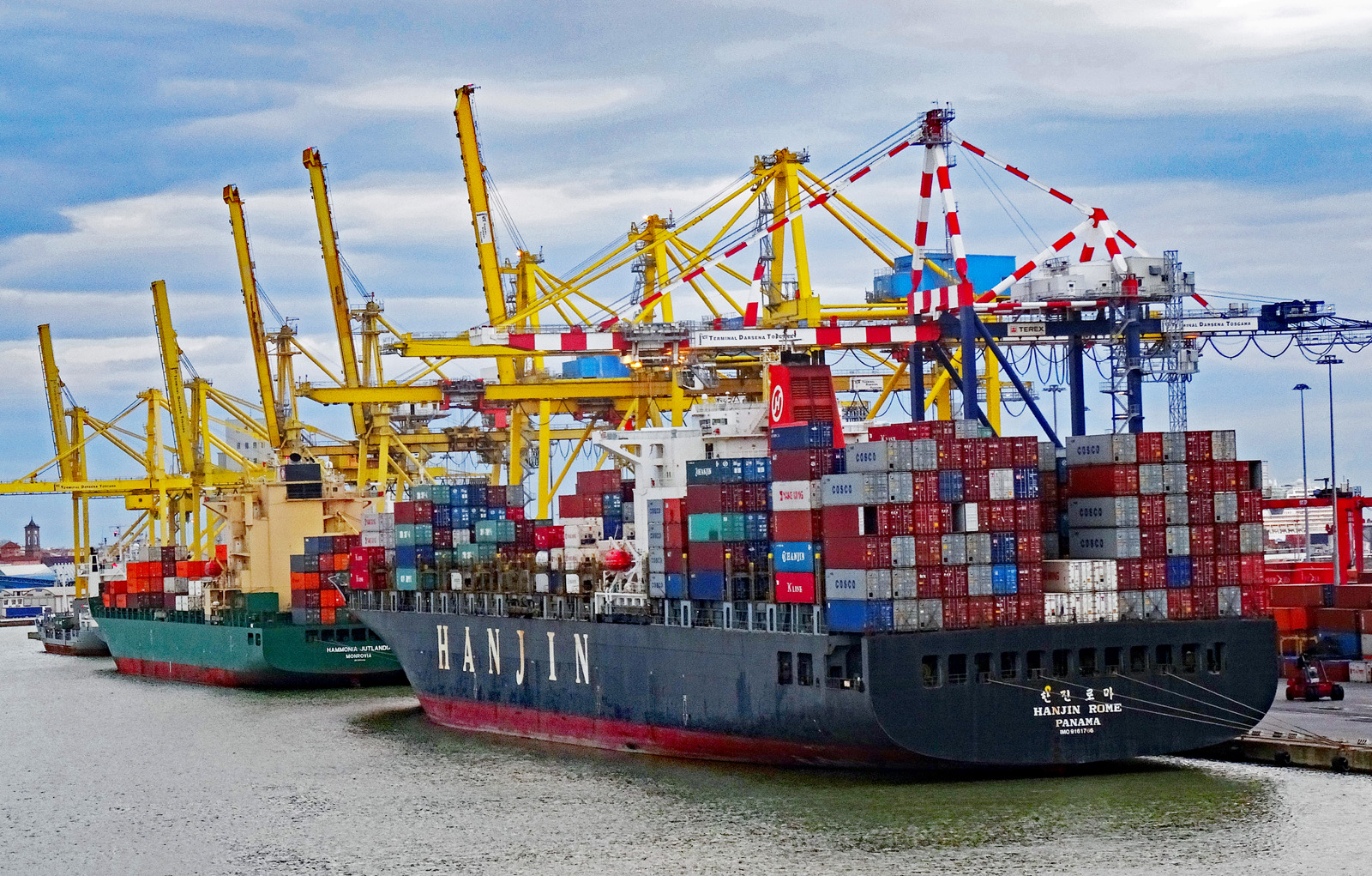 More costly imports are also contributing to higher prices. New post-Brexit trading rules are estimated to have reduced imports from the EU to the UK by about a quarter in the first half of 2021. In the USA, import tariffs on Chinese goods have almost entirely been passed on to US customers in the form of higher prices. Chinese telecoms giant Huawei said last year that sanctions imposed on the company by the USA in 2019 were affecting US suppliers and global customers.
More costly imports are also contributing to higher prices. New post-Brexit trading rules are estimated to have reduced imports from the EU to the UK by about a quarter in the first half of 2021. In the USA, import tariffs on Chinese goods have almost entirely been passed on to US customers in the form of higher prices. Chinese telecoms giant Huawei said last year that sanctions imposed on the company by the USA in 2019 were affecting US suppliers and global customers.
- The end of pandemic support
Governments are ending the support given to businesses during the pandemic. Public spending and borrowing increased across the world leading to tax rises. This has contributed to rises in the cost-of-living, while most people’s wages have lagged behind.
Main concerns for the UK inflation
With rapidly rising prices, the economic decisions people will have to make are much harder. The main concerns for UK households include increases in energy costs, food prices, rent and interest rates on borrowing. All of these concerns come at a time when the government prepares to increase national insurance contributions for workers in April. There has been some pressure from MPs to scrap the tax rise so as to ease the pressure on living costs. It can be argued that there are fairer ways to increase taxes than through national insurance. However, the plan is relatively progressive, and scrapping the rise could be a badly targeted way of helping the poorest households with their energy bills.
Energy Bills
Electricity and gas bills for a typical household are expected to increase on average by £693 a year in April, which, as we have seen, is a 54% increase. Around 18 million households on standard tariffs will see an average increase from £1277 to £1971 per year. And around 4.5 million prepayment customers will see an average increase of £708 – from £1309 to £2017. Energy bills won’t rise immediately for customers on fixed rates, but many are likely to see a significant increase when their deal ends.
Bills are going up because the energy price cap is being raised. The energy price cap is an example of a maximum price being imposed on the market; it is the maximum price suppliers in England, Wales and Scotland can charge households for their energy. Energy firms can increase bills by 54% when the new cap is introduced in April. The price cap is currently reviewed every 6 months and it is expected that that prices will rise again in October.
Energy price rises are likely to hit Britain’s poorest households the hardest as they spend proportionately more of their income on energy, a problem exacerbated by many living in poorly insulated homes. More people are thus expected to find themselves facing fuel poverty. This means that they spend a disproportionate amount of their income on energy and cannot afford to heat their homes adequately. According to the Resolution Foundation, the poorest will see their energy spend rise from 8.5% to 12% of their total household budget, three times the percentage for the richest.
The way fuel poverty is measured varies around the UK. In Scotland, a household is in fuel poverty if more than 10% of its income is spent on fuel and its remaining income isn’t enough to maintain an adequate standard of living. It is expected that the number of homes facing ‘fuel stress’ across the UK will treble to 6.3 million after April. It will, however, have the greatest impact on pensioners, people in local authority housing and low-income single-adult households who on average could be forced to spend over 50% of their income on gas and electricity. The Resolution Foundation thinktank has warned that UK households are facing a ‘cost of living catastrophe’.
Food
 Low-income households also spend a larger proportion than average on food and will therefore be relatively more affected by increases in food prices. Food and non-alcoholic drink prices were up by 4.2% in the year to December 2021. The Monetary Policy Committee has stated that food price inflation is expected to increase in coming months, given higher input costs. It has been estimated by the thinktank, Food Foundation, that 4.7m Britons, equivalent to 8.8% of the population, are struggling to feed themselves and are regularly going a day without eating.
Low-income households also spend a larger proportion than average on food and will therefore be relatively more affected by increases in food prices. Food and non-alcoholic drink prices were up by 4.2% in the year to December 2021. The Monetary Policy Committee has stated that food price inflation is expected to increase in coming months, given higher input costs. It has been estimated by the thinktank, Food Foundation, that 4.7m Britons, equivalent to 8.8% of the population, are struggling to feed themselves and are regularly going a day without eating.
Supermarkets have also raised their concerns about future increases. Tesco’s chairman John Allan has predicted that the worst is yet to come, pointing to 5% as a likely figure for food price inflation by the spring. He cited high energy prices, both for Tesco and its suppliers, as a key factor behind the expected rise.
It has been observed that the Smart Price, Basics and Value range products offered by supermarkets as lower-cost alternatives are stealthily being extinguished from the shelves. This is leaving shoppers with no choice but to ‘level up’ to the supermarkets’ own better-quality branded goods – usually in smaller quantities at larger prices. The managing director of Iceland, Richard Walker, has stated that his stores are not losing customers to other competitors or to better offers, but to food banks and to hunger. This is a highly concerning statement given that 2.5m citizens were forced by an array of desperate circumstances to use food banks over the past year.
Rent
 Private rents are also rising at their fastest rate in five years, intensifying the increase in the cost of living for millions of households. Data from the ONS reveal that the average cost of renting in the UK rose by 2% in 2021. This was the largest annual increase since 2017. The East Midlands had the biggest increase in average rental prices, with tenants paying 3.6% more than a year earlier. However, due to falling demand for city flats during lockdown, as people favoured working from home, London had the smallest increase at 0.1%. Nevertheless, as Covid restrictions are removed, renters, including office workers and students, are now returning back to cities. This is now pushing up rental prices with demand outpacing supply.
Private rents are also rising at their fastest rate in five years, intensifying the increase in the cost of living for millions of households. Data from the ONS reveal that the average cost of renting in the UK rose by 2% in 2021. This was the largest annual increase since 2017. The East Midlands had the biggest increase in average rental prices, with tenants paying 3.6% more than a year earlier. However, due to falling demand for city flats during lockdown, as people favoured working from home, London had the smallest increase at 0.1%. Nevertheless, as Covid restrictions are removed, renters, including office workers and students, are now returning back to cities. This is now pushing up rental prices with demand outpacing supply.
The property website Zoopla found newly advertised rental prices were rising much faster across the UK. It said the average rent jumped 8.3% in the final three months of 2021 to £969 a month. This increase in rental prices, combined with the general rise in prices will place additional pressure on the government to increase support for vulnerable families. The housing charity, Shelter, has reported an increase in people who are struggling to pay their rent and even pay their electricity. With Covid-era protections having ended, if people struggle to pay, they are faced with eviction or even homelessness. There are calls for the government to support such people by reversing welfare cuts.
Insurer, Legal & General, has announced an additional investment over the next 5 years of £2.5bn on its ‘build to rent’ schemes. The aim is to provide more than 7000 purpose-built rental homes in UK towns and cities. L&G claims that the additional homes are part of the solution to the rental problem, with rent increases being capped at 5% for five years. However, sceptics claim the company is simply trying to cash in on the booming market and there are calls for further government action. The Joseph Rowntree Foundation claim that renters will struggle as rents in some areas have risen as much as 8%. Despite this, housing benefit has been frozen for two years and therefore there are calls for government to urgently relink housing benefit to the real cost of renting.
Articles
- UK inflation forecast to hit 8% in April amid cost of living crisis
The Guardian, Phillip Inman (16/2/22)
- Inflation: Seven reasons the cost of living is going up around the world
BBC News, Beth Timmins and Daniel Thomas (20/1/22)
- Why are gas bills so high and what’s the energy price cap?
BBC News (4/2/22)
- What is the UK’s inflation rate and why is the cost of living going up?
BBC News (16/2/22)
- In numbers: what is fuelling Britain’s cost of living crisis?
The Guardian, Richard Partington and Ashley Kirk (3/2/22)
- Rising cost of living in the UK
House of Commons Library, Research Briefing, Brigid Francis-Devine, Daniel Harari, Matthew Keep and Paul Bolton (8/2/22)
- Rising cost of living leaves 4.7mn Britons struggling to feed themselves
Financial Times, Bethan Staton (6/2/22)
- UK cost of living crisis merits a full response
Financial Times, The editorial board (3/2/22)
- UK cost of living crisis intensifies
Financial Times, Darren Dodd (19/1/22)
- The cost of living crisis – who is hit by recent price increases?
IFS, Peter Levell and Heidi Karjalainen (17/11/21)
- The cost of living crunch
IFS, Robert Joyce, Heidi Karjalainen, Peter Levell and Tom Waters (12/1/22)
- Fastest rent rise in five years adds to concerns over UK cost of living crisis
The Guardian, Georgina Quach (16/2/22)
Questions
- What other measures of inflation are used beside CPI inflation? How do they differ?
- If all consumers are facing approximately the same price increases for any given good or service, why are poor people being disproportionately hit by rising prices?
- For what reasons might the rate of inflation (a) rise further; (b) begin to fall?
- Examine a developed country other than the UK and find out how inflation is affecting its population. Is its experience similar to that in the UK? Does it differ in any way?
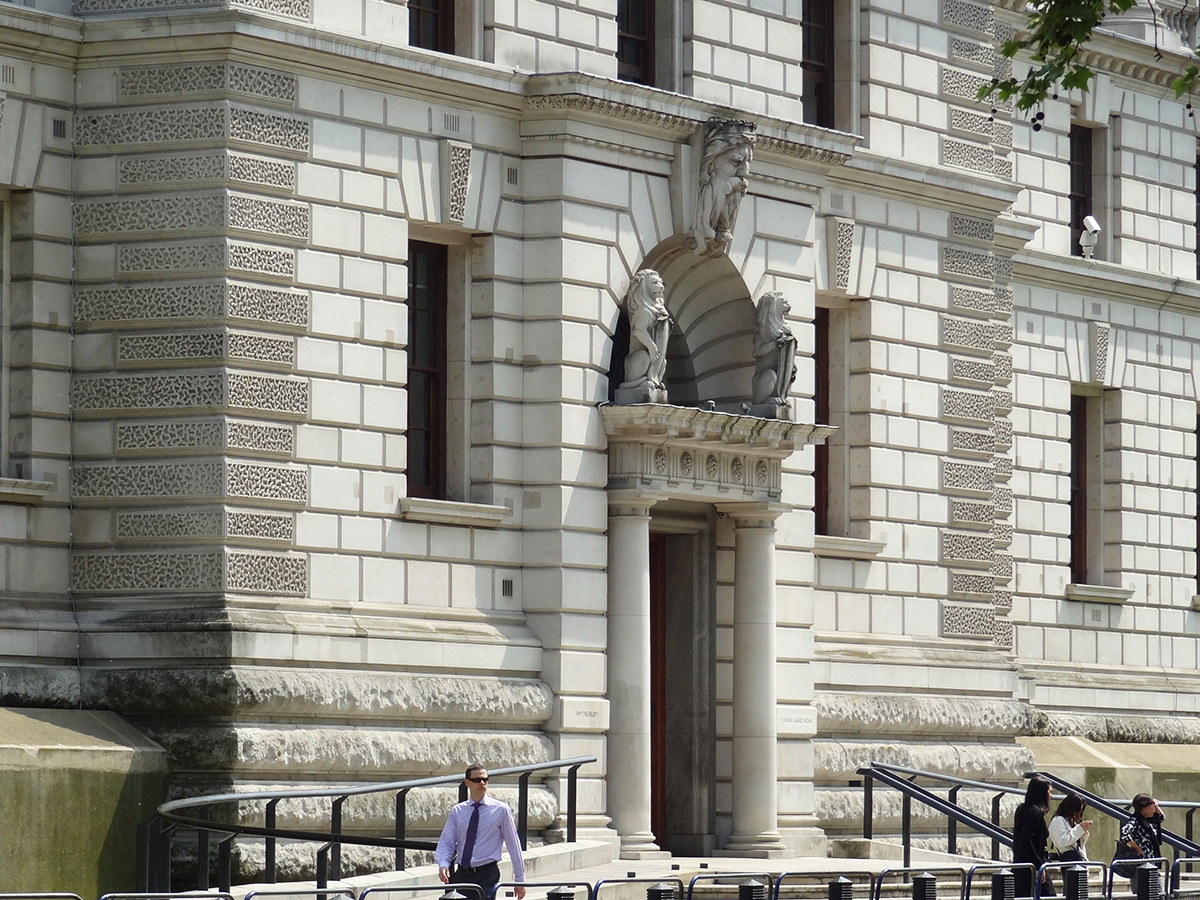 The UK government has made much of its spending commitments in the UK Budget and Spending Review delivered on 27 October 2021. Spending on transport infrastructure, green energy and health care figured prominently. The government claimed that these were to help achieve its objectives of economic growth, carbon reduction and ‘levelling up’. This means that government expenditure will be around 42% of GDP for the five years from 2022 (from 1988 to 2000 it averaged 36%). Although it temporarily rose to 52% in 2020/21, this was the result of supporting the economy through the pandemic. But does this mean that the government is now a ‘Keynesian’ one?
The UK government has made much of its spending commitments in the UK Budget and Spending Review delivered on 27 October 2021. Spending on transport infrastructure, green energy and health care figured prominently. The government claimed that these were to help achieve its objectives of economic growth, carbon reduction and ‘levelling up’. This means that government expenditure will be around 42% of GDP for the five years from 2022 (from 1988 to 2000 it averaged 36%). Although it temporarily rose to 52% in 2020/21, this was the result of supporting the economy through the pandemic. But does this mean that the government is now a ‘Keynesian’ one?
When the economy is in recession, as was the case in 2020 with the effects of the pandemic, increased government expenditure financed by borrowing rather than taxation is the classic Keynesian remedy to boost aggregate demand and close the output gap. The increased injection of spending works through the multiplier process to raise equilibrium national income and reduce unemployment.
But is this the objective of the extra spending announced in October 2021? To answer this, it is important to look at forecasts for the state of the economy with no change in government policy and at the balance of government expenditure and taxation resulting from the Budget. The first chart shows public sector net borrowing from 2006/7 and forecast to 2026/7. The green and red lines from 2021/22 onwards give the PSNB forecasts with and without the October 2021 measures.
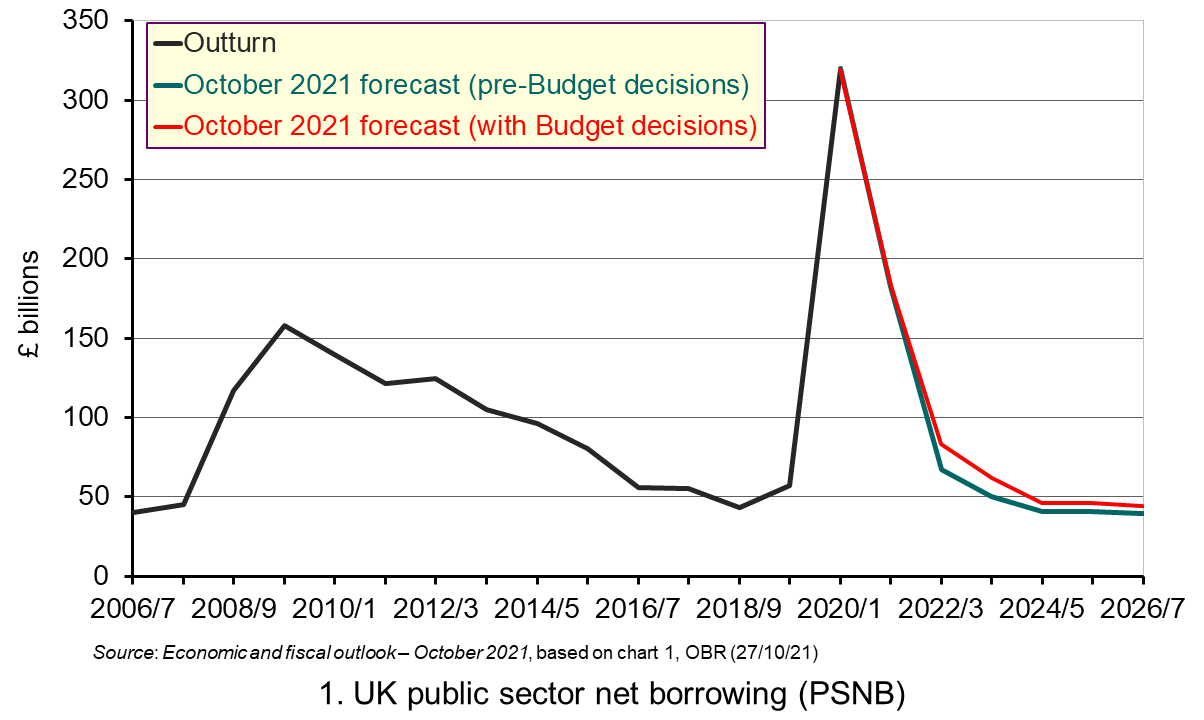 As you can see, there was a large increase in the PSNB in 2020/21, reflecting the government’s measures to support firms and workers during the pandemic. (Click here for a PowerPoint of the chart.) This was very much a Keynesian response, where a large budget deficit was necessary to support aggregate demand. It was also to protect the supply side of the economy by enabling firms to survive.
As you can see, there was a large increase in the PSNB in 2020/21, reflecting the government’s measures to support firms and workers during the pandemic. (Click here for a PowerPoint of the chart.) This was very much a Keynesian response, where a large budget deficit was necessary to support aggregate demand. It was also to protect the supply side of the economy by enabling firms to survive.
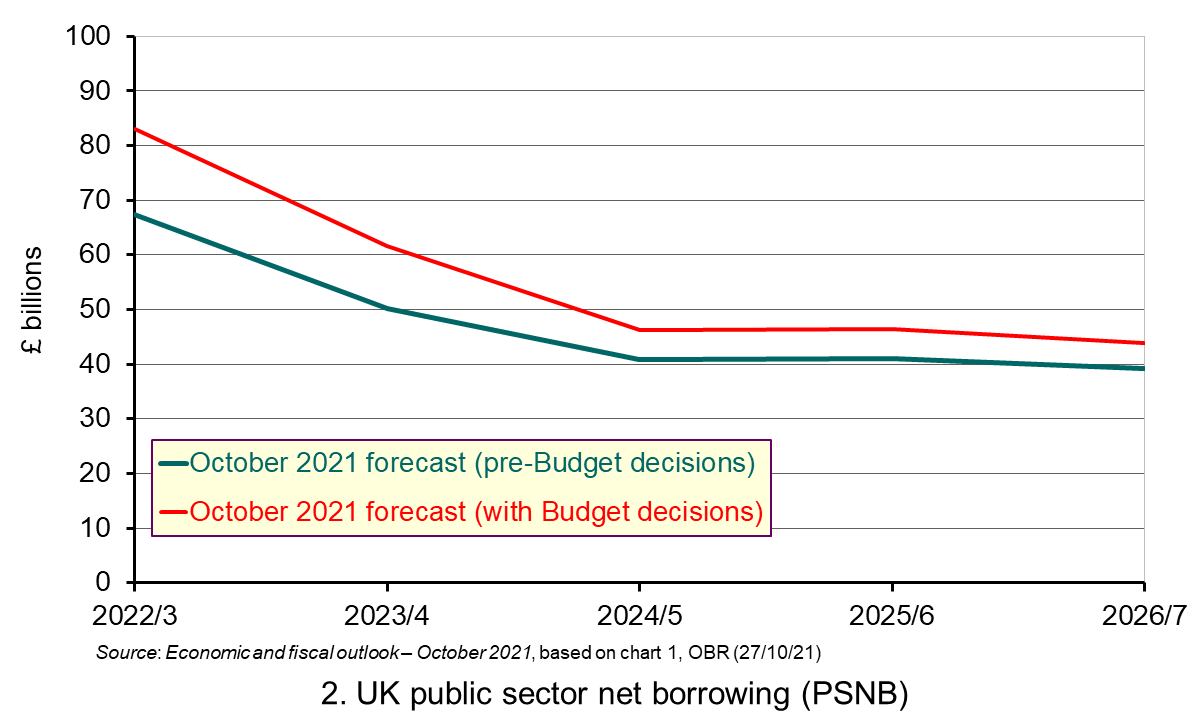 But could the October 2021 announcements also be seen as a Keynesian response to the macroeconomic situation? If we redraw Chart 1, focusing just on the forecast period and adjust the vertical scale, we can see that the measures have a net effect of increasing the PSNB and thus acting as a stimulus to aggregate demand. (Click here for a PowerPoint of the chart.) The figures are shown in the following table, which shows the totals from Table 5.1 in the Autumn Budget and Spending Review 2021 document:
But could the October 2021 announcements also be seen as a Keynesian response to the macroeconomic situation? If we redraw Chart 1, focusing just on the forecast period and adjust the vertical scale, we can see that the measures have a net effect of increasing the PSNB and thus acting as a stimulus to aggregate demand. (Click here for a PowerPoint of the chart.) The figures are shown in the following table, which shows the totals from Table 5.1 in the Autumn Budget and Spending Review 2021 document:
Effects of Spending Review and Budget 2021 on PSNB (+ = increase in PSNB)

At first sight, it would seem that the Budget was mildly expansionary. To see how much so, the Office for Budget Responsibility (OBR) measures the ‘fiscal stance’ using the ‘cyclically adjusted primary deficit (CAPD)’. This is PSNB minus interest payments and minus expenditures and tax revenues that fluctuate with the cycle and which therefore act as automatic stabilisers. The OBR’s forecast of the CAPD shows it to be expansionary, but decreasing over time. In 2021/22, there is forecast to be a net injection of around 3.2% (excluding ‘virus-related’ support), falling to 2.7% in 2022/23 and then gradually to around 0.6% by 2026/27. So it does seem that fiscal policy remains expansionary throughout the period, but less and less so.
But this alone does not make it ‘Keynesian’. A Keynesian Budget would be one that uses fiscal policy to adjust aggregate demand (AD) according to whether AD is forecast to be deficient or excessive without the Budget measures. To operate a Keynesian Budget, it would be necessary to forecast the output gap without any policy measures. If was forecast to be negative (a deficiency of demand, with equilibrium output below the potential level), then an expansionary policy should be pursued by raising government expenditure, cutting taxes or some combination of the two. If it was forecast to be positive (an excess demand, with equilibrium output above the potential level), then a contractionary/deflationary policy should be pursued by cutting government expenditure, raising taxes or some combination of the two.
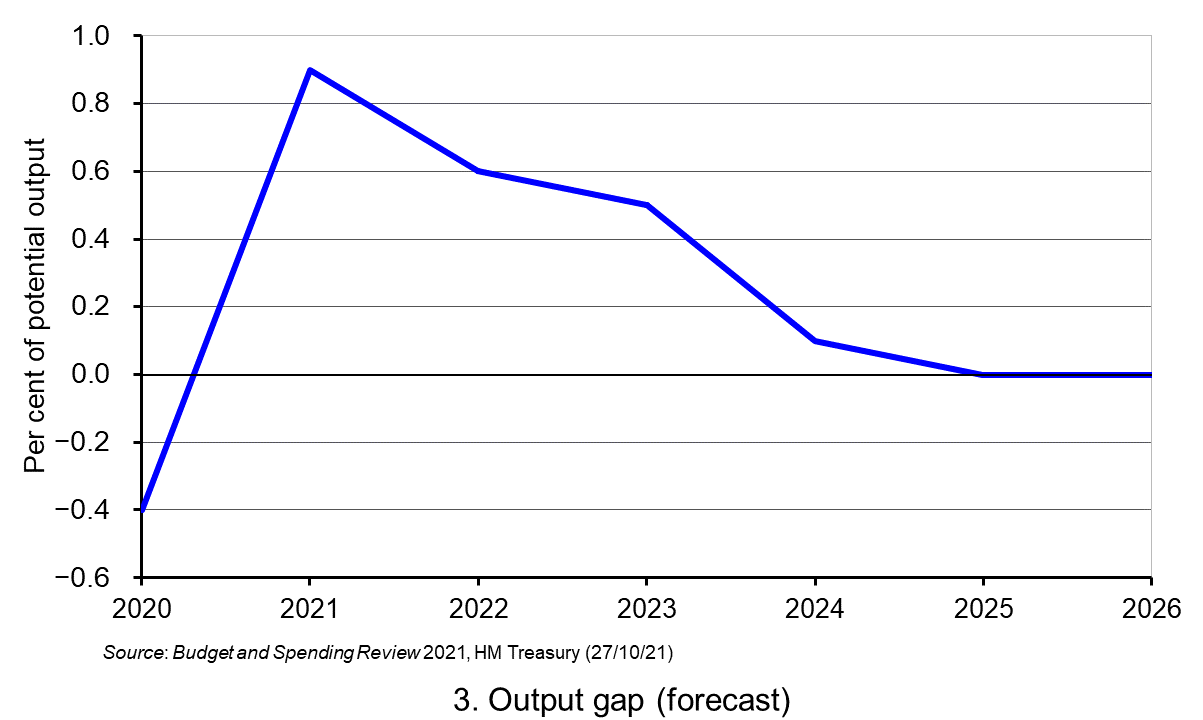 So what is the forecast for the output gap? The OBR states that, after being negative in 2020
So what is the forecast for the output gap? The OBR states that, after being negative in 2020
(–0.4% of potential GDP), it has risen substantially to 0.9% in 2021 with the rapid bounce back from the pandemic. But it is forecast to remain positive, albeit declining, until reaching zero in 2025. This is illustrated in Chart 3. (Click here for a PowerPoint of the chart.) So fiscal policy remains mildly expansionary until 2025, after having provided a considerable stimulus in 2021.
This is not normally what a Keynesian economist would recommend. Fiscal policy should be designed to achieve a zero output gap. With the output gap being substantially positive in 2021, there is a problem of excess demand. This can be seen in supply-chain difficulties and labour shortages in certain areas and higher inflation, with CPI inflation predicted by the OBR to rise to 4.4 per cent in 2022. The combination of higher prices, the rise in national insurance from April 2022 by 1.25 percentage points and the freezing of income tax personal allowances will squeeze living standards. And the cancelling of the £20 per week uplift to Universal Credit and no increase in its rate for the unemployed will put particular pressure on some of the poorest people.
 The government is hoping that the rise in government expenditure will have beneficial supply-side effects and increase potential national income. The aim is to create a high-wage, high-skilled, high-productivity economy though investment in innovation, infrastructure and skills. As the OBR states, ‘The rebounding economy has provided the Chancellor with a Budget windfall that he has added to with tax rises that lift the tax burden to its highest since the early 1950s’.
The government is hoping that the rise in government expenditure will have beneficial supply-side effects and increase potential national income. The aim is to create a high-wage, high-skilled, high-productivity economy though investment in innovation, infrastructure and skills. As the OBR states, ‘The rebounding economy has provided the Chancellor with a Budget windfall that he has added to with tax rises that lift the tax burden to its highest since the early 1950s’.
It remains to be seen whether the extra spending on education, training, infrastructure and R&D will be sufficient to achieve the long-term growth the Chancellor is seeking. The OBR is forecasting very modest growth into the longer term when the bounce back has worked through. Real GDP is forecast to grow on average by just 1.5% per year from 2024 to 2026. What is more, the OBR sees permanent scarring effects of around 2% of GDP from the pandemic and around 4% of GDP from Brexit.
Articles
Analysis
Documents
Data
Questions
- What do you understand by ‘fiscal stance’?
- What are ‘automatic fiscal stabilisers? How might they affect GDP over the next few years?
- If the government had chosen to pursue a zero output gap from 2022/23 onwards, how would this have affected the balance between total government expenditure and taxation in the 2021 Budget and Spending Review?
- Provide a critique of the Budget from the left.
- Provide a critique of the budget from the right.
- Was this a ‘Green Budget’?
- Is the Budget following the ‘golden rule’ of fiscal policy?
- Look through Table 5.1 in the Budget and Spending Review document (linked below). Which of the measures will have the most substantial effect on aggregate demand?
 The first Budget of the new UK Labour government was announced on 30 October 2024. It contained a number of measures that will help to tackle inequality. These include extra spending on health and education. This will benefit households on lower incomes the most as a percentage of net income. Increases in tax, by contrast, will be paid predominantly by those on higher incomes. The Chart opposite (taken from the Budget Report) illustrates this. It shows that the poorest 10% will benefit from the largest percentage gain, while the richest 10% will be the only decile that loses.
The first Budget of the new UK Labour government was announced on 30 October 2024. It contained a number of measures that will help to tackle inequality. These include extra spending on health and education. This will benefit households on lower incomes the most as a percentage of net income. Increases in tax, by contrast, will be paid predominantly by those on higher incomes. The Chart opposite (taken from the Budget Report) illustrates this. It shows that the poorest 10% will benefit from the largest percentage gain, while the richest 10% will be the only decile that loses. It has been an objective of governments for several years to relate the minimum wage to the median wage. In 2015, the Conservative Government set a target of raising the minimum wage rate to 60 per cent of median hourly earnings by 2020. When that target was hit a new one was set to reach two-thirds of median hourly earnings by 2024.
It has been an objective of governments for several years to relate the minimum wage to the median wage. In 2015, the Conservative Government set a target of raising the minimum wage rate to 60 per cent of median hourly earnings by 2020. When that target was hit a new one was set to reach two-thirds of median hourly earnings by 2024. Figure 1 shows the growth in minimum wage rates since their introduction in 1999. The figures are real figures (i.e. after taking into account CPI inflation) and are expressed as an index, with 1999 = 100. The chart also shows the growth in real median hourly pay. (Click here for a Powerpoint.)
Figure 1 shows the growth in minimum wage rates since their introduction in 1999. The figures are real figures (i.e. after taking into account CPI inflation) and are expressed as an index, with 1999 = 100. The chart also shows the growth in real median hourly pay. (Click here for a Powerpoint.) The UK minimum wage compares relatively favourably with other high-income economies. Figure 2 shows minimum wage rates in 12 high-income countries in 2023 – the latest year for which data are available. (Click here for a PowerPoint.) The red bars (striped) show hourly minimum wage rates in US dollars at purchasing-power parity (PPP) rates. PPP rates correct current exchange rates to reflect the purchasing power of each country’s currency. The blue bars (plain) show minimum wage rates as a percentage of the median wage rate. In 2023 the UK had the fourth highest minimum wage of the 12 countries on this measure (59.6%). As we have seen above, the 2025 rate is expected to be 2/3 of the median rate.
The UK minimum wage compares relatively favourably with other high-income economies. Figure 2 shows minimum wage rates in 12 high-income countries in 2023 – the latest year for which data are available. (Click here for a PowerPoint.) The red bars (striped) show hourly minimum wage rates in US dollars at purchasing-power parity (PPP) rates. PPP rates correct current exchange rates to reflect the purchasing power of each country’s currency. The blue bars (plain) show minimum wage rates as a percentage of the median wage rate. In 2023 the UK had the fourth highest minimum wage of the 12 countries on this measure (59.6%). As we have seen above, the 2025 rate is expected to be 2/3 of the median rate. This is illustrated in Figure 3 (click here for a PowerPoint). Assume that the minimum wage is initially the equilibrium wage rate We. Now assume that the minimum wage is raised to Wmin. This will cause a surplus of labour (i.e. unemployment) of Q3 – Q2. Labour supply rises from Q1 to Q3 and the demand for labour falls from Q1 to Q2.
This is illustrated in Figure 3 (click here for a PowerPoint). Assume that the minimum wage is initially the equilibrium wage rate We. Now assume that the minimum wage is raised to Wmin. This will cause a surplus of labour (i.e. unemployment) of Q3 – Q2. Labour supply rises from Q1 to Q3 and the demand for labour falls from Q1 to Q2. Assume initially that there is no minimum wage. The supply of labour to the monopsony employer is given by curve SL1, which is also the average cost of labour ACL1. A higher employment by the firm will drive up the wage; a lower employment will drive it down. This gives a marginal cost of labour curve of MCL1. Profit-maximising employment will be Q1, where the marginal cost of labour equals the marginal revenue product of labour (MRPL). The wage, given by the SL1 (=ACL1) line will be W1.
Assume initially that there is no minimum wage. The supply of labour to the monopsony employer is given by curve SL1, which is also the average cost of labour ACL1. A higher employment by the firm will drive up the wage; a lower employment will drive it down. This gives a marginal cost of labour curve of MCL1. Profit-maximising employment will be Q1, where the marginal cost of labour equals the marginal revenue product of labour (MRPL). The wage, given by the SL1 (=ACL1) line will be W1.  What, however, has concerned commentators more is the rise in employers’ National Insurance contributions (NICs) that were announced in the Budget. In April 2025, the rate will increase from 13.8% to 15%. Employers’ NICs are paid for each employee on all wages above a certain annual threshold. This threshold will fall in April from £9100 to £5000. So the cost to an employer of an employee earning £38 000 per annum in 2024/25 would be £38 000 + ((£38 000 – £9100) × 0.138) = £41 988.20. For the year 2025/26 it will rise to £38 000 + ((£38 000 – £5000) × 0.15) = £42 950. This is a rise of 2.29%. (Note that £38 000 will be approximately the median wage in 2025/26.)
What, however, has concerned commentators more is the rise in employers’ National Insurance contributions (NICs) that were announced in the Budget. In April 2025, the rate will increase from 13.8% to 15%. Employers’ NICs are paid for each employee on all wages above a certain annual threshold. This threshold will fall in April from £9100 to £5000. So the cost to an employer of an employee earning £38 000 per annum in 2024/25 would be £38 000 + ((£38 000 – £9100) × 0.138) = £41 988.20. For the year 2025/26 it will rise to £38 000 + ((£38 000 – £5000) × 0.15) = £42 950. This is a rise of 2.29%. (Note that £38 000 will be approximately the median wage in 2025/26.) This is the first of three blogs looking at inflation, at its effect on household budgets and at monetary policy to bring inflation back to the target rate. This first one takes an overview.
This is the first of three blogs looking at inflation, at its effect on household budgets and at monetary policy to bring inflation back to the target rate. This first one takes an overview.  Despite easing somewhat, the CPI inflation rate is showing signs of persistence – meaning that it is taking time for it to return to target. One way of understanding this persistence is to look at a measure of inflation known as core inflation. This inflation rate measure excludes energy, food, alcoholic beverages and tobacco prices, all of which are notoriously volatile. Core inflation thus captures underlying inflationary pressures.
Despite easing somewhat, the CPI inflation rate is showing signs of persistence – meaning that it is taking time for it to return to target. One way of understanding this persistence is to look at a measure of inflation known as core inflation. This inflation rate measure excludes energy, food, alcoholic beverages and tobacco prices, all of which are notoriously volatile. Core inflation thus captures underlying inflationary pressures. The increase in the Bank Rate is reflected in the increases in mortgage rates shown in Chart 2 (click
The increase in the Bank Rate is reflected in the increases in mortgage rates shown in Chart 2 (click  Chart 3 provides a visual picture of the typical annual repayment costs facing first-time buyers as a percentage of earnings after tax and national insurance (click
Chart 3 provides a visual picture of the typical annual repayment costs facing first-time buyers as a percentage of earnings after tax and national insurance (click  The Monetary Policy Committee increased Bank Rate to 3% from the previous rate of 2.25%. This 75-basis point increase is the largest since 1989 and is the eighth rise since December. What is more, the Bank has warned that it will not stop there. These increases in interest rates are there to try to tackle inflation, which rose to 10.1% in September and is expected to be 11% for the final quarter of this year. Soaring prices are a growing concern for UK households, with the cost of living rising at the fastest rate for 40 years. It is feared that such increases in the Bank’s base rate will only worsen household circumstances.
The Monetary Policy Committee increased Bank Rate to 3% from the previous rate of 2.25%. This 75-basis point increase is the largest since 1989 and is the eighth rise since December. What is more, the Bank has warned that it will not stop there. These increases in interest rates are there to try to tackle inflation, which rose to 10.1% in September and is expected to be 11% for the final quarter of this year. Soaring prices are a growing concern for UK households, with the cost of living rising at the fastest rate for 40 years. It is feared that such increases in the Bank’s base rate will only worsen household circumstances. With the Bank warning of the longest recession since records began, what does this actually mean? Economies experience periods of growth and periods of slowdown or even decline in real GDP. However, a recession is defined as when a country’s economy shrinks for two three-month periods (quarters) in a row. The last time the UK experienced a recession was in 2020 during the height of the pandemic. During a recession, businesses typically make less profits, pay falls, some people may lose their jobs and unemployment rises. This means that the government receives less money in taxation to use on public services such as health and education. Graduates and school leavers could find it harder to get their first job, while others may find it harder to be promoted or to get big enough pay rises to keep pace with price increases. However, the pain of a recession is typically not felt equally across society, and inequality can increase.
With the Bank warning of the longest recession since records began, what does this actually mean? Economies experience periods of growth and periods of slowdown or even decline in real GDP. However, a recession is defined as when a country’s economy shrinks for two three-month periods (quarters) in a row. The last time the UK experienced a recession was in 2020 during the height of the pandemic. During a recession, businesses typically make less profits, pay falls, some people may lose their jobs and unemployment rises. This means that the government receives less money in taxation to use on public services such as health and education. Graduates and school leavers could find it harder to get their first job, while others may find it harder to be promoted or to get big enough pay rises to keep pace with price increases. However, the pain of a recession is typically not felt equally across society, and inequality can increase. Those with mortgages are rightly feeling nervous about the impact that further increases in mortgage interest rates will have on their budgets. Variable mortgage rates and new fixed rates have been rising for several months because of this year’s run of rate rises but they shot up after the
Those with mortgages are rightly feeling nervous about the impact that further increases in mortgage interest rates will have on their budgets. Variable mortgage rates and new fixed rates have been rising for several months because of this year’s run of rate rises but they shot up after the  It is the case that the lasting effects of the pandemic, the war in Ukraine and the energy shock have all played their part in the current economic climate. However, it could be argued that the Bank and the government are now making decisions that will inflict further pain and sacrifice for millions of households, who are already facing multi-thousand-pound increases in mortgage, energy and food bills.
It is the case that the lasting effects of the pandemic, the war in Ukraine and the energy shock have all played their part in the current economic climate. However, it could be argued that the Bank and the government are now making decisions that will inflict further pain and sacrifice for millions of households, who are already facing multi-thousand-pound increases in mortgage, energy and food bills.
 Consumers would not normally notice price rises from month to month. However, prices are now rising so quickly that it is clear for everyone to see. What is more, average pay is not keeping up. There are workers in a few sectors, such as lorry drivers, who are in high demand, and therefore their wages are rising faster than prices. But the majority of workers won’t see such increases in pay. In the 12 months to January, prices rose by 5.5% on average, but regular pay, excluding bonuses, on average rose by only 4.7%, meaning that they fell by 0.8% in real terms.
Consumers would not normally notice price rises from month to month. However, prices are now rising so quickly that it is clear for everyone to see. What is more, average pay is not keeping up. There are workers in a few sectors, such as lorry drivers, who are in high demand, and therefore their wages are rising faster than prices. But the majority of workers won’t see such increases in pay. In the 12 months to January, prices rose by 5.5% on average, but regular pay, excluding bonuses, on average rose by only 4.7%, meaning that they fell by 0.8% in real terms. Oil prices slumped at the start of the pandemic, but demand has rocketed back since, and oil prices have hit a seven-year high. The price of gas has also shot up, leaving people around the world with eye-watering central heating bills. Home energy bills in the UK are set to rise by 54% in April when Ofgem, the energy regulator, raises the price cap.
Oil prices slumped at the start of the pandemic, but demand has rocketed back since, and oil prices have hit a seven-year high. The price of gas has also shot up, leaving people around the world with eye-watering central heating bills. Home energy bills in the UK are set to rise by 54% in April when Ofgem, the energy regulator, raises the price cap. More costly imports are also contributing to higher prices. New post-Brexit trading rules are estimated to have reduced imports from the EU to the UK by about a quarter in the first half of 2021. In the USA, import tariffs on Chinese goods have almost entirely been passed on to US customers in the form of higher prices. Chinese telecoms giant Huawei said last year that sanctions imposed on the company by the USA in 2019 were affecting US suppliers and global customers.
More costly imports are also contributing to higher prices. New post-Brexit trading rules are estimated to have reduced imports from the EU to the UK by about a quarter in the first half of 2021. In the USA, import tariffs on Chinese goods have almost entirely been passed on to US customers in the form of higher prices. Chinese telecoms giant Huawei said last year that sanctions imposed on the company by the USA in 2019 were affecting US suppliers and global customers. Low-income households also spend a larger proportion than average on food and will therefore be relatively more affected by increases in food prices. Food and non-alcoholic drink prices were up by 4.2% in the year to December 2021. The Monetary Policy Committee has stated that food price inflation is expected to increase in coming months, given higher input costs. It has been estimated by the thinktank, Food Foundation, that 4.7m Britons, equivalent to 8.8% of the population, are struggling to feed themselves and are regularly going a day without eating.
Low-income households also spend a larger proportion than average on food and will therefore be relatively more affected by increases in food prices. Food and non-alcoholic drink prices were up by 4.2% in the year to December 2021. The Monetary Policy Committee has stated that food price inflation is expected to increase in coming months, given higher input costs. It has been estimated by the thinktank, Food Foundation, that 4.7m Britons, equivalent to 8.8% of the population, are struggling to feed themselves and are regularly going a day without eating.  Private rents are also rising at their fastest rate in five years, intensifying the increase in the cost of living for millions of households. Data from the ONS reveal that the average cost of renting in the UK rose by 2% in 2021. This was the largest annual increase since 2017. The East Midlands had the biggest increase in average rental prices, with tenants paying 3.6% more than a year earlier. However, due to falling demand for city flats during lockdown, as people favoured working from home, London had the smallest increase at 0.1%. Nevertheless, as Covid restrictions are removed, renters, including office workers and students, are now returning back to cities. This is now pushing up rental prices with demand outpacing supply.
Private rents are also rising at their fastest rate in five years, intensifying the increase in the cost of living for millions of households. Data from the ONS reveal that the average cost of renting in the UK rose by 2% in 2021. This was the largest annual increase since 2017. The East Midlands had the biggest increase in average rental prices, with tenants paying 3.6% more than a year earlier. However, due to falling demand for city flats during lockdown, as people favoured working from home, London had the smallest increase at 0.1%. Nevertheless, as Covid restrictions are removed, renters, including office workers and students, are now returning back to cities. This is now pushing up rental prices with demand outpacing supply.  The UK government has made much of its spending commitments in the UK Budget and Spending Review delivered on 27 October 2021. Spending on transport infrastructure, green energy and health care figured prominently. The government claimed that these were to help achieve its objectives of economic growth, carbon reduction and ‘levelling up’. This means that government expenditure will be around 42% of GDP for the five years from 2022 (from 1988 to 2000 it averaged 36%). Although it temporarily rose to 52% in 2020/21, this was the result of supporting the economy through the pandemic. But does this mean that the government is now a ‘Keynesian’ one?
The UK government has made much of its spending commitments in the UK Budget and Spending Review delivered on 27 October 2021. Spending on transport infrastructure, green energy and health care figured prominently. The government claimed that these were to help achieve its objectives of economic growth, carbon reduction and ‘levelling up’. This means that government expenditure will be around 42% of GDP for the five years from 2022 (from 1988 to 2000 it averaged 36%). Although it temporarily rose to 52% in 2020/21, this was the result of supporting the economy through the pandemic. But does this mean that the government is now a ‘Keynesian’ one? As you can see, there was a large increase in the PSNB in 2020/21, reflecting the government’s measures to support firms and workers during the pandemic. (Click
As you can see, there was a large increase in the PSNB in 2020/21, reflecting the government’s measures to support firms and workers during the pandemic. (Click  But could the October 2021 announcements also be seen as a Keynesian response to the macroeconomic situation? If we redraw Chart 1, focusing just on the forecast period and adjust the vertical scale, we can see that the measures have a net effect of increasing the PSNB and thus acting as a stimulus to aggregate demand. (Click
But could the October 2021 announcements also be seen as a Keynesian response to the macroeconomic situation? If we redraw Chart 1, focusing just on the forecast period and adjust the vertical scale, we can see that the measures have a net effect of increasing the PSNB and thus acting as a stimulus to aggregate demand. (Click 
 So what is the forecast for the output gap? The OBR states that, after being negative in 2020
So what is the forecast for the output gap? The OBR states that, after being negative in 2020 The government is hoping that the rise in government expenditure will have beneficial supply-side effects and increase potential national income. The aim is to create a high-wage, high-skilled, high-productivity economy though investment in innovation, infrastructure and skills. As the OBR states, ‘The rebounding economy has provided the Chancellor with a Budget windfall that he has added to with tax rises that lift the tax burden to its highest since the early 1950s’.
The government is hoping that the rise in government expenditure will have beneficial supply-side effects and increase potential national income. The aim is to create a high-wage, high-skilled, high-productivity economy though investment in innovation, infrastructure and skills. As the OBR states, ‘The rebounding economy has provided the Chancellor with a Budget windfall that he has added to with tax rises that lift the tax burden to its highest since the early 1950s’.